#west african food bay area
Explore tagged Tumblr posts
Text

Could new super highway lure military regimes back into the West African fold
Read more click here
#west african fold#west african food#west african food near me#west african food recipes#west african food portland#west african food list#west african food seattle#west african food nyc#west african food dc#west african food fufu#west african food minneapolis#west african folk art#west african folk song#west african folk#west african folk music#west african folk dance#famous west african food#popular west african foods#west african food boston#west african food brooklyn park#west african food brooklyn#west african food bay area#west african food baltimore#west african food before colonization#west african food brisbane#west african food berlin#west african food bristol#west african food brands#best west african food near me#b african kitchen
0 notes
Photo




Flowers of eucalyptus are sublime.
Eucalyptus is a genus of over seven hundred species of flowering trees. It is much argued about around the world - at present eucalyptus is the world most planted tree. It is used for timber, healing properties of bark and leaves, honey-making, dyes for silk and wool, repelling mosquitos and food supplement. History tells us a few difficult facts too: "In 1787, when a fleet of ships laden with English criminals and their keepers arrived in Australia’s Botany Bay for purposes of colonization, these newcomers were unprepared for the environment they found. Australian life had evolved for millions of years in isolation from the flora and fauna of the American, European, Asian, and African land masses.
This was as true of the Australian gum, or eucalyptus tree, as it was of the kangaroo — both species for which no close cousins could be found on the shores of the West. Historian and art critic John Hughes, in his book on the colonization of Australia, The Fatal Shore, says that “it took at least two decades for colonial watercolorists to get the gum trees right, so that they did not look like English oaks or elms.”
Australia’s aborigines had lived with the eucalyptus as with the kangaroo and the wallaby and the dingo for millennia — indeed, eucalyptus composed (and today still composes) three-quarters of all Australian forest. The trees were indispensable to the natives; rickety canoes were fashioned from the bark; and during the frequent droughts, stores of life-sustaining water were squeezed from the roots. The English, unfamiliar with this lore, sometimes died of thirst on ground in which water-rich eucalyptus roots abounded.
If the Australian aborigines were never to extend beyond their homeland in a great migrant flood, the eucalyptus tree had a different fate in store. It was to be transplanted to regions all over the globe — from Ethiopia and Madagascar to Spain, Israel, Kenya, Brazil, and California. A United Nations study from the 1950s holds that eucalyptus is an exceedingly valuable tree for purposes of reforestation and industry and advocated its liberal use in developing areas.
In 1858, William C. Walker — owner of the Golden Gate Nursery in San Francisco — published a handwritten catalogue in which he advertised three species of eucalyptus for sale at five to ten dollars each. An article in the 1902 issue of the U.S. Department of Agriculture’s “Bureau of Forestry Bulletin” provides additional history of the eucalyptus in California."
https://www.sandiegoreader.com/.../cover-ecupalyptus-it-is/
18 notes
·
View notes
Text
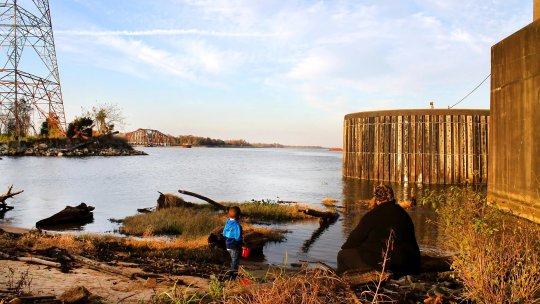
"It's crazy to think they would have sailed right past here," Darron Patterson said, pulling his car onto a scrap of grass overlooking the murky Mobile River. As president of the Clotilda Descendants Association, Patterson is well versed in talking about the voyage of the Clotilda – the last known slave ship to reach America. His great-great-grandfather was Kupollee, later renamed Pollee Allen; one of the 110 men, women and children cruelly stolen from Benin in West Africa and brought to the US onboard the notorious ship.
The story of how Patterson's relative arrived in America aboard an illegal slaver started as a shockingly flippant bet. Fifty-two years after the US banned the importation of enslaved people, in 1860, a wealthy Alabama business owner named Timothy Meaher wagered that he could orchestrate for a haul of kidnapped Africans to sail under the noses of federal officers and evade capture.
With the assistance of Captain William Foster at the helm of an 80ft, two-mast schooner, and following a gruelling six-week transatlantic passage, he succeeded. The ship sneaked into Mobile Bay on 9 July under a veil of darkness. To conceal evidence of the crime, the distinctive-looking schooner – made from white oak frames and southern yellow pine planking – was set ablaze and scuttled to the depths of the swampy Mobile River, where it lay concealed beneath the water, its existence relegated to lore.
That is until almost 160 years later, when during a freakishly low tide, a local reporter named Ben Raines discovered a hefty chunk of shipwreck in the Mobile River, initially thought to belong to the Clotilda. It turned out to be a false alarm, but the discovery reignited interest and led to an extensive search involving multiple parties, including the Alabama Historical Commission, National Geographic Society, Search Inc and the Slave Wrecks Project. Following their exhaustive effort, in May 2019 it was finally announced that the elusive Clotilda had at long last been discovered.

A mural of the Clotilda slave ship runs alongside the freeway separating the two sides of Africatown (Credit: Carmen K Sisson/Alamy)
Three years later, the city of Mobile found itself standing on the brink of a tourism boom, as interest in the story of the Clotilda, and the lives of its resilient captives, built.
Patterson had agreed to drive me around Africatown, an area where many of the ship's captives finally settled and where Patterson himself was raised. We began the tour at this scrap of land by the Mobile River, beneath a soaring interstate bridge where a group of Clotilda slave ship descendants meet annually for their Under the Bridge festival, to "talk about how our ancestors got here and to have some food and dance," Patterson said. There was no festival that day though and the atmosphere was muted; just one woman and her grandson played by the marshy water's edge below the steady hum of traffic.
Walking back to his car, Patterson, a former sportswriter now in his 60s, recalled that growing up, Africatown was a thriving, self-sufficient place, where "the only time we needed to leave the community was to pay a utility bill" as everything needed was close to hand, aside from a post office.
Located three miles north of downtown Mobile, Africatown was founded by 32 of the original Clotilda survivors following emancipation at the end of the Civil War, in 1865. Longing for the homeland they'd been brutally ripped from, the residents set up their own close-knit community to blend their African traditions with American folkways, raising cattle and farming the land. One of the first towns established and controlled by African Americans in the US, Africatown had its own churches, barbershops, stores (one of which was owned by Patterson's uncle); and the Mobile County Training School, a public school that became the backbone of the community.
However, this once-vibrant neighbourhood fell on hard times when a freeway was constructed in the heart of it in 1991, and industrial pollution meant that many of the remaining residents eventually packed up and left. "We couldn't even hang out our washing to dry because it would get covered in ash [a product of the oil storage tanks and factories on the outskirts of Africatown]," said Patterson. With the high-profile closure of the corrugated box factory, International Paper, in 2000, and an ensuing public health lawsuit brought about by residents, Africatown's community that had swelled to 12,000 people in the 1960s plummeted to around 2,000, where it stands today.
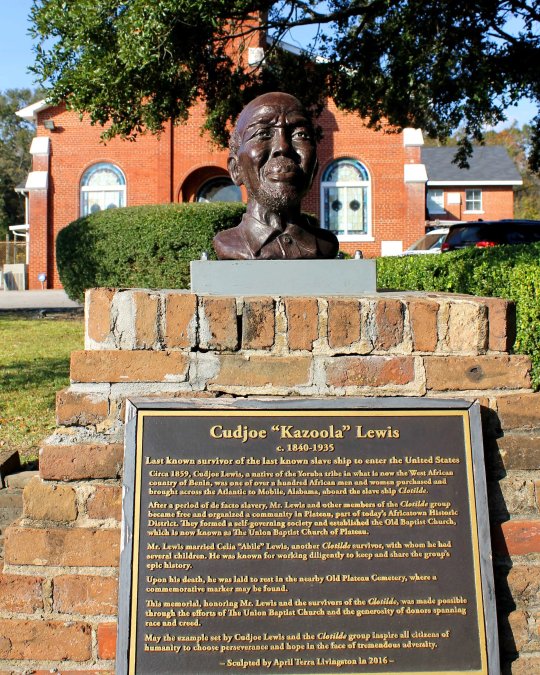
Cudjoe Kazoola Lewis, one of the Clotilda survivors and founders of Africatown, died in 1935 (Credit: Zoey Goto)
The exodus, poverty and environmental scars were visible as Patterson drove further into Africatown. The roadside was littered with abandoned factories. The quiet, residential streets were peppered with empty lots and vacant homes, some in such disrepair that their decaying walls had surrendered entirely to the creeping vines engulfing them.
But Africatown is changing, once again. With the discovery of the ship's remnants came the interest necessary to rebuild and preserve this historical place; an influx of attention and funds that is affecting everything from personal relationships to history to the fortune of the neighbourhood. Because, though the story of the Clotilda was known – and the lives of the original passengers were so well documented that photos, interviews and even film footage existed – without evidence of the vessel, the history was buried and it was not in the interest of the white population to acknowledge the truth of how they had arrived. Finding the vessel allowed their story to be affirmed and truth to be restored after decades of denial.
In the years since the Clotilda was discovered, the wreck has undergone extensive archaeological exploration to determine the likelihood of raising it safely. The ripple effect of media and public interest has meant a slew of government, community and private funding for Africatown's revitalisation, including The Africatown Redevelopment Corporation, which is using grants to restore homes in disrepair and demolishing and rebuilding derelict lots. Added to this is a $3.6 million payout from a BP oil spill settlement that has been earmarked for the long-awaited rebuilding of the Africatown Welcome Center, which was swept away in 2005 by Hurricane Katrina.
Patterson drove me to his grandmother's house and pulled over to chat with an elderly neighbour on her porch ("no photos, mind", she requested politely). Unlike some of the other descendent families, he told me, growing up he was told little of his ancestry. "I think my folks may have been embarrassed," he reflected, recalling that the smuggled captives had faced many humiliations, including being stripped naked for the voyage. "That must have just broke their will," Patterson said.
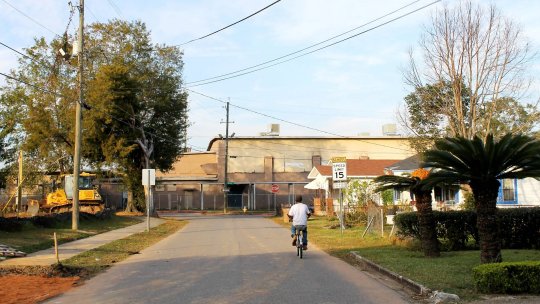
Africatown was one of the first towns established and controlled by African Americans in the US (Credit: Zoey Goto)
The 2019 announcement of the ship's discovery galvanised Patterson's curiosity, and he started to piece together his heritage, at which point his "whole life changed". He's since become hands-on in ensuring the story is told accurately, including an onscreen role in the film Descendant premiering at the 2022 Sundance Film Festival and as co-producer of the second installment of the forthcoming documentary The 110: The Last Enslaved Africans Brought to America about the Clotilda's passengers.
For Patterson, the discovery of the infamous ship brings fresh hope that Africatown is on the eve of a renaissance. Following years of denial, "the ship's very existence has finally been affirmed, so a burden has been lifted," said Mobile County Commissioner Merceria Ludgood. "That's every bit as important to the ethos of Africatown as the housing revitalisation currently happening."
Although there's a lack of restaurants and tourism facilities, that could be all set to change as well, said Ludgood, who is helping to set up the Africatown Heritage House, a permanent museum created in collaboration with the History Museum of Mobile to chart the history of Africatown. "Hopefully cottage industries will spring up, owned by people who live in the community," she said, noting that the discovery of the Clotilda has given Africatown's community a boost, resonating far beyond economics.
Next on Patterson's tour was the Africatown Heritage House, situated in the hub of the neighbourhood, overlooked by a row of modest, well-kept bungalows on a palm-lined avenue. Under construction at the time of my visit, the museum was due to open in early summer 2022 and will include a gallery of West African artefacts as well as salvaged sections of the Clotilda shipwreck, presented in preservation tanks.
“This is actually the best documented Middle Passage story we have as a nation”
It promises a unique insight, given the relatively recent timing of the Clotilda voyage in relation to the history of slavery. "This is actually the best documented Middle Passage story we have as a nation," explained Meg McCrummen Fowler, director of the History Museum of Mobile. "There's just an abundance of sources, mostly because it occurred so late. Several of the people on the ship lived well into the 20th Century, so instead of silence there's diaries, there's ship records."
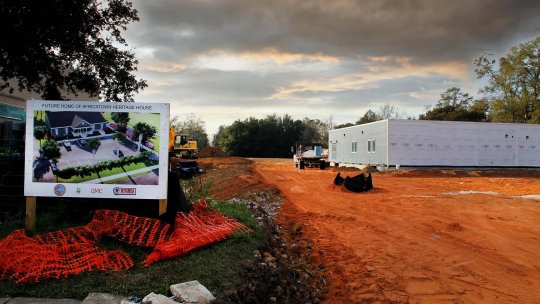
Work has started on the Africatown Heritage House, a $1.3 million exhibit about the 110 enslaved West Africans and the Clotilda vessel (Credit: Zoey Goto)
Further regeneration projects on the horizon include a footbridge connecting the two areas of Africatown currently divided by the freeway. Water tours taking visitors close to the shipwreck site are scheduled to launch in spring 2022, and a few local residents ahead of the curve are offering walking tours of Africatown.
While tourists have yet to arrive in serious numbers, Africatown faces a familiar set of challenges to other US neighbourhoods experiencing rapid revitalisation, including ensuring the whole community supports change and that residents don't fall through the cracks. But Patterson said that the Africatown community is united in its mission.
"We're all on board with this," he said.
The final stop on our tour was the cemetery where many of the Clotilda's enslaved have been laid to rest. As we walked, Patterson told me that with the light currently shinning on this troubling chapter of history, he has hopes that there will be enough sustained interest to generate the funds needed to raise the schooner from the water.
Though the true impact of this fabled ship's discovery is yet to be seen, for Patterson, it presents an opportunity to lift up the Africatown community and honour the struggles of its founders. "This is about more than bricks and mortar, it's ultimately about the growth of our souls," he said, looking out over their crumbling gravestones, all facing east towards their motherland. "Finding the ship has finally validated our truth."
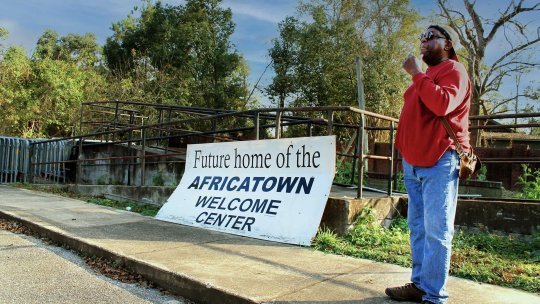
Unlike some of the other descendent families, Darron Patterson was told little of his ancestry (Credit: Zoey Goto)
#Africatown#clotilda#Cudjo#The Last Known Ship of the US Slave Trade#alabama#mobile#Black History Matters
2 notes
·
View notes
Text
Holidays 5.25
Holidays
Africa Day
African Freedom Day (Zambia)
African Languages Day
African Liberation Day (Rastafari)
Amateur Radio Military Appreciation Day
Bojangles Day
Chuquisaca (Bolivia)
Common Arens
Cookie Monster Day
Day of Youth (Yugoslavia)
EMS Save-A-Life Day
Flitting Day (Scotland)
Geek Pride Day
George Floyd Remembrance Day
Global Change Leadership Day
GDPR Day (a.k.a. General Data Protection Regulation Day; EU)
Global Planking Day
Global Surgery Day
The Glorious 25 Day (a.k.a. Glorious Revolution, Glorious 25th of May; Discworld)
Grand Prix de Monaco begins (Monaco)
Gypsy Day
Heroes’ Day (Lesotho)
Integrity Day (Scientology)
International Heritage Breeds Day
International Missing Children’s Day (UN)
International Planking Day
International Plastic Free Day
International Skin Pigmentation Day
Julia Pierpont Day (West Virginia)
Kids Ocean Day (California)
Languedoc Day
Last Bell (Russia, post-Soviet countries) [5/25 or Friday before, if falls on a weekend]
Lemon Balm Day (French Republic)
Liberation Day (Lebanon)
Local Radio Day (UK)
Maddie May Day
May Revolution Day (Argentina)
National Adoption Day (Brazil)
National Ahmad “Captain Poodaman” Butler Day
National Bath Bomb Day
National Cody Day
National Don't Utter a Word Day
National Enzo Day
National George Day
National Hometown Area Local Day
National Missing Children's Day (US)
National Sing Out Day
National Stop the Bleed Day
National Tap Dance Day
National VTuber Day
Peruvian Clown Day (Peru)
Poetry Day (Florida)
Ramsey Lewis Day
Saint Cool Day
Self-Reliance Day
Senior Health & Fitness Day
South Liberation Day (Lebanon)
Star Wars Day
Stinky Pee Day
Tap Dance Day
Towel Day (Hitchhiker’s Guide to the Galaxy)
World Fish Migration Day
World Tarot Day
World Thyroid Day
Food & Drink Celebrations
National Brown Bag It Day [also Last Wednesday]
National Italian Beer Day
National Wine Day (US)
Independence & Related Days
Empire of New Prussia (Declared; 2018) [unrecognized]
First Government Day (Argentina; Sudan)
Jordan (from UK, 1946)
Kingdom of Africa (Declared; 2020) [unrecognized]
Kingdom of Sycamore (Declared; 2018) [unrecognized]
Lunataria (Declared; 2022) [unrecognized]
Neo-Dumnonii Kingdom (Declared; 2016) [unrecognized]
Pilatia (Declared; 2022) [unrecognized]
4th & Last Saturday in May
Amateur Radio Military Appreciation Day [9 Days before 1st Monday in June]
Defeat Depression Day (Canada) [Last Saturday]
Dillo Day [Last Saturday; Northwestern University]
Drone Day [Last Saturday]
Elmer Day (UK) [Last Saturday]
International Blacksmith’s Day [4th Saturday]
International Cavalier King Charles Spaniel Day [Last Saturday]
International Jazz Day [Saturday before Memorial Day/9 Days before 1st Monday in June]
Julia Pierpont Day (West Virginia) [Saturday before Memorial Day]
National Learn to Swim Day [Saturday before Memorial Day]
Pride in Armed Forces Day (UK) [4th Saturday]
World Enneagram Day [Last Saturday]
Weekly Holidays beginning May 25 (3rd Full Week)
Week of Solidarity with the Peoples of Non-Governing Territories (thru 5.31)
Festivals Beginning May 25, 2024
Alabama Jubilee Hot Air Balloon Classic (Decatur, Alabama) [thru 5.26]
Atlanta Caribbean Carnival (Atlanta, Georgia)
Bavarianfest (Helen, Georgia)
BBQ, Blues & Brews on the Bay (North Bend, Oregon) [thru 5.26]
Brew at the Zoo (Baltimore, Maryland) [thru 5.26]
Caribbean Festival (Mt. Airy, Maryland) [thru 5.26]
Carnaval San Francisco (San Francisco, California)
Chuck Wagon Festival (Oklahoma City, Oklahoma) [thru 5.26]
The Creekside Beer Festival (Boulder, Colorado) [thru 5.26]
FlavorFest at Mount Hope (Mount Hope, Pennsylvania (thru 5.26]
Great Alaska Craft Beer & Homebrew Festival (Haines, Alaska)
Happy Valley Strawberry Festival (Anderson, California) [thru 5.26]
Hood Canal Fjord Fest (Brinnon, Washington) [thru 5.26]
Horseshoe Crab & Shorebird Festival (Milton, Delaware)
Jersey Shore Food Truck Festival (Monmouth Park, Oceanport, New Jersey) [thru 5.27]
Koroneburg Old World Renaissance Festival (Corona, California) [6.23]
New Mexico Wine Fest: Las Cruces (Las Cruces, New Mexico) [thru 5.27]
Rib King NYC (Brooklyn, New York)
Roaring Camp Cook-Off (Felton, California) [thru 5.26]
Rockport Wine Festival (Rockport, Texas)
Rotary Art, Wine & Wheels (Mariposa, California)
Star Valley Strawberry Festival (Borden, Indiana)
Strawberry Festival (Beaver Dam, Kentucky) [thru 5.27]
Taste of Cincinnati (Cincinnati, Ohio) [thru 5.27]
Wine, Beer & Spirits Fest (Sierra Vista, Arizona) [5.26
Feast Days
Aldhelm (Christian; Saint)
St. Ambrose (Positivist; Saint)
Apollo Day (Everyday Wicca)
Barry Windsor-Smith (Artology)
Bede the Venerable (Christian; Saint)
Boniface IV, Pope (Christian; Saint)
Canius (Christian; Saint)
The Cat (Muppetism)
Celebration of the Tao (The Mother of the World; Taoism)
Cookie Monster (Muppetism)
Dionysius of Milan (Christian; Saint)
Dumhade, Abbot of Iona (Christian; Saint)
Dúnchad mac Cinn Fáelad (Christian; Saint)
Edward Bulwer-Lytton (Writerism)
Gennadius (Christian; Saint)
Gerard of Lunel (Christian; Saint)
Gregory VII, Pope (Christian; Saint)
Leo (a.k.a. Lye; Christian; Saint)
Madeleine Sophie Barat (Christian; Saint)
Mary Magdalene of Pazzi (Christian; Saint)
Maximus (Mauxe) of Évreux (Christian; Saint)
Mercurius (Ancient Roman Festival of Trade & Gain)
Ralph Waldo Emerson (Writerism)
Raymond Carver (Writerism)
Robert Ludlum (Writerism)
Sara-Kali’s Day (Pagan)
Stalin Day (Church of the SubGenius; Saint)
Stan Sakai (Artology)
Towel Day (Pastafarian)
Urban I, Pope (Christian; Saint)
Urbanas Diena (Ancient Latvia)
Venerand (Christian; Saint)
William Boyer (Artology)
W.P. Kinsella (Writerism)
Zenobius of Florence (Christian; Saint)
Hebrew Calendar Holidays [Begins at Sundown Day Before]
Lag B'Omer (Hebrew harvest time) [17-18 Iyar]
Lucky & Unlucky Days
Butsumetsu (仏滅 Japan) [Unlucky all day.]
Dismal Day (Unlucky or Evil Day; Medieval Europe; 10 of 24)
Egyptian Day (Unlucky Day; Middle Ages Europe) [10 of 24]
Premieres
Alien (Film; 1979)
Back to the Future (Film; 1985)
Back to the Future Part III (Film; 1990)
Barefoot in the Park (Film; 1967)
Barnyard Babies (Happy Harmonies Cartoon; 1935)
Beyond the Great Snow Mountains, by Louis L’Amour (Novel; 1999)
The Cookie Carnival (Disney Silly Symphonies Cartoon; 1935)
Davy Crockett, King of the Wild Frontier (Film; 1955)
The Day Lincoln Was Shot, by Jim Bishop (Historical Book; 1955)
Farming Fools (Oswald the Lucky Rabbit Cartoon; 1936)
Feud with a Dude (WB MM Cartoon; 1968)
A Gander at Mother Goose (WB MM Cartoon; 1940)
The Gastronomical Me, by M.F.K. Fisher (Food Essays; 1943)
Hair-Raising Hare (WB MM Cartoon; 1946)
Harry of Monmouth, by A.M. Maugham (Novel; 1956)
He Ain’t Heavy, He’s My Brother, recorded by The Hollies (Song; 1969)
H.M.S. Pinafore, by Gilbert & Sullivan (Comic Opera; 1878)
Jesus of Montreal (Film; 1990)
Kiss Me, Kiss Me, Kiss Me, by The Cure (Album; 1987)
The Little Sister, by Raymond Chandler (Novel; 1949)
Men in Black 3 (Film; 2012)
Mickey’s Revue (Disney Cartoon; 1932)
Midnight Cowboy (Film; 1969)
Moonrise Kingdom (Film; 2012)
Nadja, by André Breton (Novel; 1928)
Paprika (Anime Film; 2007)
Pearl Harbor (Film; 2001)
Piker’s Peak (WB LT Cartoon; 1957)
The Pink Blueprint (Pink Panther Cartoon; 1966)
Pink, Plunk, Plink (Pink Panther Cartoon; 1966)
Pirates of the Caribbean: At World’s End (Film; 2007)
Safety, by Coldplay (EP: 1998)
Samstag aus Licht, by Karl Stockhausen (Opera; 1984)
The Selfish Gene, by Richard Dawkins (Science Book; 1976)
Smoky Joe (Terrytoons Cartoon; 1945)
Solo: A Star Wars Story (Film; 2018)
Star Wars, Episode IV: A New Hope (Film; 1977)
Star Wars, Episode VI: Return of the Jedi (Film; 1983)
Three Little Pigs (Silly Symphonies Cartoon; 1933)
Tubular Bells, by Mike Oldfield (Album; 1973)
Under My Kin, by Avril Lavigne (Album; 2004)
War Machine (Film; 2017)
Today’s Name Days
Beda, Gregor, Magdalene (Austria)
Spas, Spaska (Bulgaria)
Beda, Grgur, Urban (Croatia)
Viola (Czech Republic)
Urbanus (Denmark)
Urban, Urbo, Urve, Urves (Estonia)
Urpo (Finland)
Sophie (France)
Beda, Magdalene, Miriam, Urban (Germany)
Nefeli (Greece)
Orbán (Hungary)
Basileo, Beda, Erminio, Gregorio (Italy)
Anitra, Anšlavs, Ciemvaldis, Gunita (Latvia)
Almantas, Danutė, Urbonas (Lithuania)
Ragna, Ragnar (Norway)
Epifan, Grzegorz, Imisława, Maria Magdalena, Urban (Poland)
Ioan (România)
Urban (Slovakia)
Beda, Gregorio, Magdalena, María (Spain)
Urban (Sweden)
Celeste, Celestine (Ukraine)
Madalyn, Madeleine, Madeline, Madelyn, Madilyn, Marlee, Marleen, Marlena, Marlene, Marley (USA)
Today is Also…
Day of Year: Day 146 of 2024; 220 days remaining in the year
ISO: Day 6 of week 21 of 2024
Celtic Tree Calendar: Huath (Hawthorn) [Day 14 of 28]
Chinese: Month 4 (Ji-Si), Day 18 (Ji-Chou)
Chinese Year of the: Dragon 4722 (until January 29, 2025) [Wu-Chen]
Hebrew: 17 Iyar 5784
Islamic: 17 Dhu al-Qada 1445
J Cal: 26 Magenta; Fryday [26 of 30]
Julian: 12 May 2024
Moon: 94%: Waning Gibbous
Positivist: 5 St. Paul (6th Month) [St. Ambrose]
Runic Half Month: Odal (Home, Possession) [Day 1 of 15]
Season: Spring (Day 68 of 92)
Week: 3rd Full Week of May
Zodiac: Gemini (Day 5 of 31)
Calendar Changes
Odal (Home, Possession) [Half-Month 11 of 24; Runic Half-Months] (thru 6.8)
1 note
·
View note
Text
Holidays 5.25
Holidays
Africa Day
African Freedom Day (Zambia)
African Languages Day
African Liberation Day (Rastafari)
Amateur Radio Military Appreciation Day
Bojangles Day
Chuquisaca (Bolivia)
Common Arens
Cookie Monster Day
Day of Youth (Yugoslavia)
EMS Save-A-Life Day
Flitting Day (Scotland)
Geek Pride Day
George Floyd Remembrance Day
Global Change Leadership Day
GDPR Day (a.k.a. General Data Protection Regulation Day; EU)
Global Planking Day
Global Surgery Day
The Glorious 25 Day (a.k.a. Glorious Revolution, Glorious 25th of May; Discworld)
Grand Prix de Monaco begins (Monaco)
Gypsy Day
Heroes’ Day (Lesotho)
Integrity Day (Scientology)
International Heritage Breeds Day
International Missing Children’s Day (UN)
International Planking Day
International Plastic Free Day
International Skin Pigmentation Day
Julia Pierpont Day (West Virginia)
Kids Ocean Day (California)
Languedoc Day
Last Bell (Russia, post-Soviet countries) [5/25 or Friday before, if falls on a weekend]
Lemon Balm Day (French Republic)
Liberation Day (Lebanon)
Local Radio Day (UK)
Maddie May Day
May Revolution Day (Argentina)
National Adoption Day (Brazil)
National Ahmad “Captain Poodaman” Butler Day
National Bath Bomb Day
National Cody Day
National Don't Utter a Word Day
National Enzo Day
National George Day
National Hometown Area Local Day
National Missing Children's Day (US)
National Sing Out Day
National Stop the Bleed Day
National Tap Dance Day
National VTuber Day
Peruvian Clown Day (Peru)
Poetry Day (Florida)
Ramsey Lewis Day
Saint Cool Day
Self-Reliance Day
Senior Health & Fitness Day
South Liberation Day (Lebanon)
Star Wars Day
Stinky Pee Day
Tap Dance Day
Towel Day (Hitchhiker’s Guide to the Galaxy)
World Fish Migration Day
World Tarot Day
World Thyroid Day
Food & Drink Celebrations
National Brown Bag It Day [also Last Wednesday]
National Italian Beer Day
National Wine Day (US)
Independence & Related Days
Empire of New Prussia (Declared; 2018) [unrecognized]
First Government Day (Argentina; Sudan)
Jordan (from UK, 1946)
Kingdom of Africa (Declared; 2020) [unrecognized]
Kingdom of Sycamore (Declared; 2018) [unrecognized]
Lunataria (Declared; 2022) [unrecognized]
Neo-Dumnonii Kingdom (Declared; 2016) [unrecognized]
Pilatia (Declared; 2022) [unrecognized]
4th & Last Saturday in May
Amateur Radio Military Appreciation Day [9 Days before 1st Monday in June]
Defeat Depression Day (Canada) [Last Saturday]
Dillo Day [Last Saturday; Northwestern University]
Drone Day [Last Saturday]
Elmer Day (UK) [Last Saturday]
International Blacksmith’s Day [4th Saturday]
International Cavalier King Charles Spaniel Day [Last Saturday]
International Jazz Day [Saturday before Memorial Day/9 Days before 1st Monday in June]
Julia Pierpont Day (West Virginia) [Saturday before Memorial Day]
National Learn to Swim Day [Saturday before Memorial Day]
Pride in Armed Forces Day (UK) [4th Saturday]
World Enneagram Day [Last Saturday]
Weekly Holidays beginning May 25 (3rd Full Week)
Week of Solidarity with the Peoples of Non-Governing Territories (thru 5.31)
Festivals Beginning May 25, 2024
Alabama Jubilee Hot Air Balloon Classic (Decatur, Alabama) [thru 5.26]
Atlanta Caribbean Carnival (Atlanta, Georgia)
Bavarianfest (Helen, Georgia)
BBQ, Blues & Brews on the Bay (North Bend, Oregon) [thru 5.26]
Brew at the Zoo (Baltimore, Maryland) [thru 5.26]
Caribbean Festival (Mt. Airy, Maryland) [thru 5.26]
Carnaval San Francisco (San Francisco, California)
Chuck Wagon Festival (Oklahoma City, Oklahoma) [thru 5.26]
The Creekside Beer Festival (Boulder, Colorado) [thru 5.26]
FlavorFest at Mount Hope (Mount Hope, Pennsylvania (thru 5.26]
Great Alaska Craft Beer & Homebrew Festival (Haines, Alaska)
Happy Valley Strawberry Festival (Anderson, California) [thru 5.26]
Hood Canal Fjord Fest (Brinnon, Washington) [thru 5.26]
Horseshoe Crab & Shorebird Festival (Milton, Delaware)
Jersey Shore Food Truck Festival (Monmouth Park, Oceanport, New Jersey) [thru 5.27]
Koroneburg Old World Renaissance Festival (Corona, California) [6.23]
New Mexico Wine Fest: Las Cruces (Las Cruces, New Mexico) [thru 5.27]
Rib King NYC (Brooklyn, New York)
Roaring Camp Cook-Off (Felton, California) [thru 5.26]
Rockport Wine Festival (Rockport, Texas)
Rotary Art, Wine & Wheels (Mariposa, California)
Star Valley Strawberry Festival (Borden, Indiana)
Strawberry Festival (Beaver Dam, Kentucky) [thru 5.27]
Taste of Cincinnati (Cincinnati, Ohio) [thru 5.27]
Wine, Beer & Spirits Fest (Sierra Vista, Arizona) [5.26
Feast Days
Aldhelm (Christian; Saint)
St. Ambrose (Positivist; Saint)
Apollo Day (Everyday Wicca)
Barry Windsor-Smith (Artology)
Bede the Venerable (Christian; Saint)
Boniface IV, Pope (Christian; Saint)
Canius (Christian; Saint)
The Cat (Muppetism)
Celebration of the Tao (The Mother of the World; Taoism)
Cookie Monster (Muppetism)
Dionysius of Milan (Christian; Saint)
Dumhade, Abbot of Iona (Christian; Saint)
Dúnchad mac Cinn Fáelad (Christian; Saint)
Edward Bulwer-Lytton (Writerism)
Gennadius (Christian; Saint)
Gerard of Lunel (Christian; Saint)
Gregory VII, Pope (Christian; Saint)
Leo (a.k.a. Lye; Christian; Saint)
Madeleine Sophie Barat (Christian; Saint)
Mary Magdalene of Pazzi (Christian; Saint)
Maximus (Mauxe) of Évreux (Christian; Saint)
Mercurius (Ancient Roman Festival of Trade & Gain)
Ralph Waldo Emerson (Writerism)
Raymond Carver (Writerism)
Robert Ludlum (Writerism)
Sara-Kali’s Day (Pagan)
Stalin Day (Church of the SubGenius; Saint)
Stan Sakai (Artology)
Towel Day (Pastafarian)
Urban I, Pope (Christian; Saint)
Urbanas Diena (Ancient Latvia)
Venerand (Christian; Saint)
William Boyer (Artology)
W.P. Kinsella (Writerism)
Zenobius of Florence (Christian; Saint)
Hebrew Calendar Holidays [Begins at Sundown Day Before]
Lag B'Omer (Hebrew harvest time) [17-18 Iyar]
Lucky & Unlucky Days
Butsumetsu (仏滅 Japan) [Unlucky all day.]
Dismal Day (Unlucky or Evil Day; Medieval Europe; 10 of 24)
Egyptian Day (Unlucky Day; Middle Ages Europe) [10 of 24]
Premieres
Alien (Film; 1979)
Back to the Future (Film; 1985)
Back to the Future Part III (Film; 1990)
Barefoot in the Park (Film; 1967)
Barnyard Babies (Happy Harmonies Cartoon; 1935)
Beyond the Great Snow Mountains, by Louis L’Amour (Novel; 1999)
The Cookie Carnival (Disney Silly Symphonies Cartoon; 1935)
Davy Crockett, King of the Wild Frontier (Film; 1955)
The Day Lincoln Was Shot, by Jim Bishop (Historical Book; 1955)
Farming Fools (Oswald the Lucky Rabbit Cartoon; 1936)
Feud with a Dude (WB MM Cartoon; 1968)
A Gander at Mother Goose (WB MM Cartoon; 1940)
The Gastronomical Me, by M.F.K. Fisher (Food Essays; 1943)
Hair-Raising Hare (WB MM Cartoon; 1946)
Harry of Monmouth, by A.M. Maugham (Novel; 1956)
He Ain’t Heavy, He’s My Brother, recorded by The Hollies (Song; 1969)
H.M.S. Pinafore, by Gilbert & Sullivan (Comic Opera; 1878)
Jesus of Montreal (Film; 1990)
Kiss Me, Kiss Me, Kiss Me, by The Cure (Album; 1987)
The Little Sister, by Raymond Chandler (Novel; 1949)
Men in Black 3 (Film; 2012)
Mickey’s Revue (Disney Cartoon; 1932)
Midnight Cowboy (Film; 1969)
Moonrise Kingdom (Film; 2012)
Nadja, by André Breton (Novel; 1928)
Paprika (Anime Film; 2007)
Pearl Harbor (Film; 2001)
Piker’s Peak (WB LT Cartoon; 1957)
The Pink Blueprint (Pink Panther Cartoon; 1966)
Pink, Plunk, Plink (Pink Panther Cartoon; 1966)
Pirates of the Caribbean: At World’s End (Film; 2007)
Safety, by Coldplay (EP: 1998)
Samstag aus Licht, by Karl Stockhausen (Opera; 1984)
The Selfish Gene, by Richard Dawkins (Science Book; 1976)
Smoky Joe (Terrytoons Cartoon; 1945)
Solo: A Star Wars Story (Film; 2018)
Star Wars, Episode IV: A New Hope (Film; 1977)
Star Wars, Episode VI: Return of the Jedi (Film; 1983)
Three Little Pigs (Silly Symphonies Cartoon; 1933)
Tubular Bells, by Mike Oldfield (Album; 1973)
Under My Kin, by Avril Lavigne (Album; 2004)
War Machine (Film; 2017)
Today’s Name Days
Beda, Gregor, Magdalene (Austria)
Spas, Spaska (Bulgaria)
Beda, Grgur, Urban (Croatia)
Viola (Czech Republic)
Urbanus (Denmark)
Urban, Urbo, Urve, Urves (Estonia)
Urpo (Finland)
Sophie (France)
Beda, Magdalene, Miriam, Urban (Germany)
Nefeli (Greece)
Orbán (Hungary)
Basileo, Beda, Erminio, Gregorio (Italy)
Anitra, Anšlavs, Ciemvaldis, Gunita (Latvia)
Almantas, Danutė, Urbonas (Lithuania)
Ragna, Ragnar (Norway)
Epifan, Grzegorz, Imisława, Maria Magdalena, Urban (Poland)
Ioan (România)
Urban (Slovakia)
Beda, Gregorio, Magdalena, María (Spain)
Urban (Sweden)
Celeste, Celestine (Ukraine)
Madalyn, Madeleine, Madeline, Madelyn, Madilyn, Marlee, Marleen, Marlena, Marlene, Marley (USA)
Today is Also…
Day of Year: Day 146 of 2024; 220 days remaining in the year
ISO: Day 6 of week 21 of 2024
Celtic Tree Calendar: Huath (Hawthorn) [Day 14 of 28]
Chinese: Month 4 (Ji-Si), Day 18 (Ji-Chou)
Chinese Year of the: Dragon 4722 (until January 29, 2025) [Wu-Chen]
Hebrew: 17 Iyar 5784
Islamic: 17 Dhu al-Qada 1445
J Cal: 26 Magenta; Fryday [26 of 30]
Julian: 12 May 2024
Moon: 94%: Waning Gibbous
Positivist: 5 St. Paul (6th Month) [St. Ambrose]
Runic Half Month: Odal (Home, Possession) [Day 1 of 15]
Season: Spring (Day 68 of 92)
Week: 3rd Full Week of May
Zodiac: Gemini (Day 5 of 31)
Calendar Changes
Odal (Home, Possession) [Half-Month 11 of 24; Runic Half-Months] (thru 6.8)
0 notes
Text
Things to do in July in the DMV!
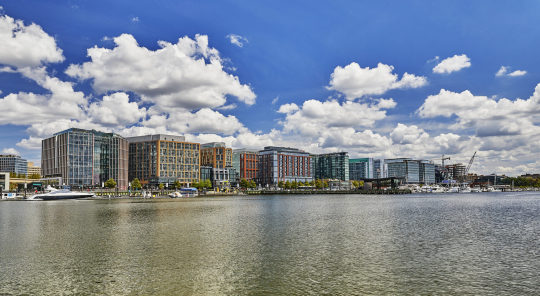
July is hot – and we’re not just talking fireworks. Outdoor fun is abundant around here. Whether you believe that the U.S. is a melting pot or a salad bowl, our area is home to a delicious mix of cultures and experiences. Check out these activities to know where to go and what to expect.
July 1
Family Ice Cream Social at Heritage Frederick Heritage Frederick Garden Located behind the big white house/museum at 24 East Church Street Frederick, Md.
This FREE ice cream social from 1 to 4 p.m. is happening compliments of the volunteers of Heritage Frederick. Ice cream will be served and good old fashioned games
July 1
DC Black Food and Wine Festival 2700 Martin Luther King Jr Ave SE Washington, DC
Savor the samplings from Black-owned food and wine vendors and enjoy live performances at this event that brings together the best of African-American cuisine and culture.
July 1
A Taste of the DMV REPUBLIQ 2122 24th Place NE Washington, DC
This food and cultural festival is for ages 21 and older and features craft drinks, a beer garden, wine tastings, live art and music, contests, games and entertainment. Foods include Latin, French, African, Greek, Asian, Italian, and more.
July 2
The Biggest Cookout Ever
Merriweather Park at Symphony Woods 10431 Little Patuxent Parkway Columbia, Md.
The Biggest Cookout Ever is an outdoor food festival for guests 21 years or older. This ultimate cookout experience promotes inclusivity, diversity, and community.
July 7 – 9
Romanian Weekend at The Wharf 760 Maine Ave SW Washington, DC
Organized by the Romanian Embassy and the Romanian Cultural Institute, this weekend event highlights Romanian culture – old and new – and includes folk music and dancing, jazz and hip-hop, traditional crafts demonstrations, literary performances, culinary presentations, wine tasting, and more.
July 8
USA/Alexandria Birthday Celebration Oronoco Bay Park 100 Madison St. Alexandria, Va.
The City of Alexandria celebrates its 274th birthday and the USA’s 247th birthday on Sat., July 8, with a performance by the Alexandria Symphony Orchestra and a grand finale fireworks display at 9:30 p.m. Enjoy the big birthday experience including cupcakes, local vendors, and live music.
July 15
Key West Fest Breaux Vineyards 36888 Breaux Vineyards Lane Purcellville, Va.
Whether you feel like “lei”-ing out or dancing, the Key West Fest at Breaux’s has everything you need to cool off while enjoying fun in the sun. Food and craft vendors, live music, and of course, fine wine all add to the experience.
July 15
Archaeology Family Day George Washington’s Mount Vernon 3200 Mount Vernon Memorial Highway Mount Vernon, Va.
Meet a Mount Vernon archaeologist and explore how archaeology has shaped what we know about George and Martha Washington and the enslaved people who lived at Mount Vernon.
July 21
Don McLean American Pie 50th Anniversary Tour Birchmere Music Hall 3701 Mt. Vernon Ave. Alexandria, Va.
Grammy-award honoree, Songwriters Hall of Fame member, and BBC Lifetime Achievement Award recipient Don McLean will bring his American Pie 50th Anniversary Tour to the Birchmere Music Hall. Celebrating the 50th anniversary of one of the most iconic songs and albums ever this year, McLean will entertain fans and prove that “Bye-bye, Miss American Pie” will forever remain a classic staple in music.
July 22
The Raid: Minute-by-Minute at Harpers Ferry Allies for Freedom Room 801 Shenandoah St. Harpers Ferry, W.V.
Step back in time with this presentation that looks at the 36 hours of the raid, dissecting the movements of all 21 raiders and John Brown.
July 22
La Placita DMV Gateway Pavilion 2700 Martin Luther King Jr. Ave. SE Washington, DC
This vibrant celebration of Puerto Rican culture and community features live performances, food trucks, artisans and craft vendors, cabezudos (head puppets), and DOMINAZO, a domino tournament in partnership with the Greater Washington Hispanic Chamber of Commerce and Domino USA.
July 22
Purcellville Wine & Food Festival Dillon’s Woods Purcellville, Va.
Head to the heart of DC’s wine country for this event and enjoy food and snack vendors, live music, artists – and of course, fine wine.
July 22
Colombian Festival The Catholic University of America University Garage 3598 John McCormack Rd. NE Washington, DC
Dance, art, food and folklore galore, this festival celebrates Colombian culture, art, gastronomy, and music.
July 28
Outlaw Music Festival Merriweather Post Pavilion Columbia, Md.
The 2023 Outlaw tour celebrates Willie Nelson’s legendary life and legacy in his milestone 90th birthday year. The Maryland tour includes Willie Nelson & Family, Nathaniel Rateliff and The Night Sweats, Kurt Vile and The Violators, and more.
July 31 to Aug. 3
Twilight History for Youth Fredericksburg, Va.
Children ages 8 to 12 learn hands-on 18th-century skills, trades, and recipes during four nights, at four historic sites in Fredericksburg, Va. They’ll explore the Hugh Mercer Apothecary Shop, the Rising Sun Tavern, the Mary Washington House, and the Mary Washington Monument.
#jamierichards#realtorjamier#realestate#realestateagent#realestatetips#things to do#things to do in july#july#july in the dmv#things to do in the dmv
0 notes
Text
Learning Activity 3.5, Task 2: What has influenced me? DRAFT
Task 2: What has influenced me?
Write an essay about the cultural influences in your life
Think about the ideas, traditions, art forms, and businesses that have outside cultural origins
Include the following five areas of culture: food, fashion, architecture, leisure activities, and entertainment.
Title this blog entry as, “Learning Activity 3.5, Task 2: What has influenced me?”
Ideas for Task 2 point form (very rough sketch):
Most of Canadian fashion is influenced by European designers, such as; Adidas, Nike, H&M, Inditex, LVMH, TJX, and Kering to name a few.
The typical Canadian cuisine is unique, drawing inspirations from all over the world, but Europe again has the most influence. In recent memory, particularly East Asian and South Asian dishes have become more widespread, mostly due to the influx of immigration from those areas of the world.
Once again, architecture in Canada has roots in Europe. Mostly France and England, but neo-Classical from Italy and Brutalism from Soviet Russia also have a significant foothold.
For leisure activities, Europe and Indigenous culture share a duopoly of impact. For Europe; football, competitive swimming, baseball (cricket origins), tennis, volleyball, golf, water polo, rugby, gymnastics, and boxing, as well as much more. Hockey and basketball, while both were invented by European-descended Canadians, drew inspiration from existing Indigenous sports. Canoeing has, in contrast, remained unchanged as an Indigenous leisure activity.
Most of Canadian entertainment in its current form has European origins, like writing, cinema, and music, but these forms of entertainment also independently sprouted up all around the world.
Modern music has a multifaceted origin story, like rap and jazz being African American creations, but music theory and language all come from Europe. The modern scene in music is incredibly diverse, from K-pop and American pop, European synth and electronic music, classical music and big bands from all over West, rap and jazz from African Americans, rock and pop music from England and elsewhere, country music, and so on.
Cinema traces its origins to plays done in Greece and its modern structure from playwrights like Shakespeare and Cervantes.
Most philosophical, economical, and cultural ideas can trace their origins to Europe. Democracy from ancient Greece and its modern format in Canada from England. Law and order from ancient Greece, the Roman Empire, and the British Empire.
Most of the prominent businesses in modern day Canada are multinational organizations that have international origin. However, there are some big name brands that have existed since the fur trade, like Hudson’s Bay, which is the world’s oldest continuously operating international business.
Many traditions in Canada have European origins, like Christmas, Easter, and Halloween, but one of the most important is Thanksgiving, which is a fusion of Indigenous and European cultures. It originated in Massachusetts in 1621 when colonists and the Wampanoag tribe shared an autumn harvest.
0 notes
Text
Best Things to Do in Louisiana
located in the Deep South of the States, Louisiana is renowned for its stunning Cajun as well as Creole culture that has Acadian, French, and Spanish influences. This intoxicating mixture of food, music and even dialects is best experienced in cities like Lafayette as well as Baton Rouge - its state capital. It is not to be missed New Orleans for its fabulous French Quarter as well as the spectacular Mardi Gras celebrations, and many other tourist destinations.
Activities to enjoy things to see and do in Louisiana includes exploring the wide blend of history, culture, and heritage along with beautiful landscapes. The powerful Mississippi River forms its eastern border as it flows towards the sparkling warm waters of the Gulf of Mexico.
The beautiful delta of Louisiana is home to stunning bayous, beaches along with barrier islands, including massive alligators and beautiful plantations that are hidden within them. It is the perfect mix of nature, history, and diversity, LA's unending charms and joy de vivre make it among the most desirable destinations to visit within the south-central United States.
Hence, to enjoy a classic holiday, book your cheap flights to Louisiana soon.

Oak Alley Plantation
The most significant and fascinating historical location is located in Louisiana, Oak Alley Plantation is located in the southeast part of the state. The plantation is located in a spectacular area on the banks of the Mississippi River, it is well-known for its beautiful tree canopy that welcomes visitors to the site. The impressive antebellum architecture and stunning landscaping hide an ugly past, with slaves working on the plantation for many years making sugarcane. The visitors to Oak Alley can learn all about this and much more through a guided tour of Oak Alley, a National Historic Landmark. There's also a great dining establishment and a charming hotel on the property.
Grand Isle State Park
At the eastern end of the gorgeous barrier island named the beautiful Grand Isle State Park, which is sure to please those who love nature and outdoor activities alike. The park is situated at the point that water warm from the Gulf of Mexico meets Barataria Bay and the bayous of the Mississippi The park offers an array of stunning outdoor activities to enjoy. Although it was ravaged by a number of storms over the past few years, and impacted by oil spills like the Deepwater Horizon spill of oil, Grand Isle State Park is still beautiful and charming. In addition to taking boat trips, fishing or bird watching there are also great bathing and sunbathing options as well as canoeing, which is also one of the most popular activities.
Steamboat Natchez
An excellent way to experience New Orleans' myriad of incredible sights is to hop onto the Steamboat Natchez and enjoy a cruise on the Mississippi River. Because the city's story is inextricably connected with the River that flows through it, here's the best way for you to appreciate its rich history and warm hospitality than by boarding the charming paddle steamer. Besides enjoying the breathtaking sights from the elegant deck passengers also discover fascinating information about the ship and city when they travel along in the French Quarter. Apart from exploring the city and taking cruises, you can savor a mouth-watering Creole meal or listen to live music while traveling.
You can easily book your cheap flights to Michigan with the Lowest Flight fares and enjoy a trip.
Laura Plantation
A short distance away from Oak Alley Plantation is another one of Bayou State's most important historical sites, which is the Laura Plantation. As an element of the Louisiana African American Heritage Trail, This sprawling estate is situated on the West Bank of the Mississippi River. Founded in the year 1804, it flourished during the 19th century with slaves (both Creole and American) who worked on the sugarcane plantation. It was originally known as the Duparc Plantation and is now a newly restored Creole-style big house that is raised that visitors can explore and also a variety of slave cabins as well as outbuildings. As the property is so well preserved, visiting the property is like being transported back to the past, with fascinating and informative tours that teach visitors all about the past inhabitants and the significance of the plantation within the region.
Old State Capitol
With a unique and charming style, Its distinctive and attractive design Old State Capitol looks more like a castle than a historical governmental structure. It is located in the center of Baton Rouge on a bluff that overlooks the Mississippi River, it is one of the city's top tourist places.
Built between 1847-1852, the National Historic Landmark boasts a beautiful Gothic Revival style: crenelations and towers are visible along an impressive façade. Inside, it's equally striking and features a stunning towering staircase, and a stained glass dome in the middle of a number of beautiful galleries and halls.
The state's seat of government was relocated to the capitol building in 1932, the "Louisiana Castle was also called, was the home of different veterans' organizations for a number of decades. Today, it is home to the magnificent Museum of Political History, which has a variety of interactive and educational exhibits that focus on the past, culture, and culture of the state.
Jean Lafitte National Historical Park and Preserve
The southernmost part of the State is six locations of the magnificent Jean Lafitte National Historical Park and Preserve. With a plethora of dots around the Mississippi River Delta, they are very different from each other as some focus on Cajun culture, while others preserve battlefields and bayous.
The park was established in 1978 to safeguard and enhance Louisiana's historical, cultural, and natural treasures The park was named in honor of the legendary French pirate Jean Lafitte. The reason for this is that the privateer who smuggled walked through the streets of New Orleans' French Quarter and swam through the swampy mud that comprise the Barataria Reserve, and fought in the Chalmette Battlefield.
In addition to these amazing sites in addition, there are the fantastic Arcadian Cultural Centers at Lafayette, Eunice, and Thibodaux to make a stop at. Through interpretive and interactive exhibitions and displays, they provide a fascinating glimpse at the people and the places which have shaped the culture and the identity of the state.
Lafayette Cemetery No 1
It is known for its stunning and interesting mausoleums, tombs, and grounds, Lafayette Cemetery No 1 can be found in the beautiful Garden District of New Orleans. This is not to be confused with the other cemetery that is unclean and neglected It is a well-known and beautiful place with a wealth of stunning photographs to take of its impressive monuments and decaying tombs.
It was inaugurated in 1833 in the then-suburban area of New Orleans, the plots quickly grew in during the subsequent years. Certain sections house whole families, as the devastating yellow fever epidemics swept through New Orleans. The majority of the mausoleums are from to the present day; their elegant designs look stunningly worn and weathered amid the lush vegetation and lush undergrowth.
A location of significant architectural as well as historical and social importance, it has been used in numerous music and film videos throughout the decades. Additionally, the author Anne Rice famously emerged from a coffin at Lafayette Cemetery No 1 when she was promoting the novel Memnoch the Devil in 1995.
#lff#lowestflightfare#holidays#visit#explorepage#exploremore#travelgram#travelindustry#funactivities#fun#facts#travelguide#guide#flights#cheapflights#siteseeing#exploringthecity#travelpics#traveldiaries#travelbug#TravelAwesome#travelpic#travellers
0 notes
Photo



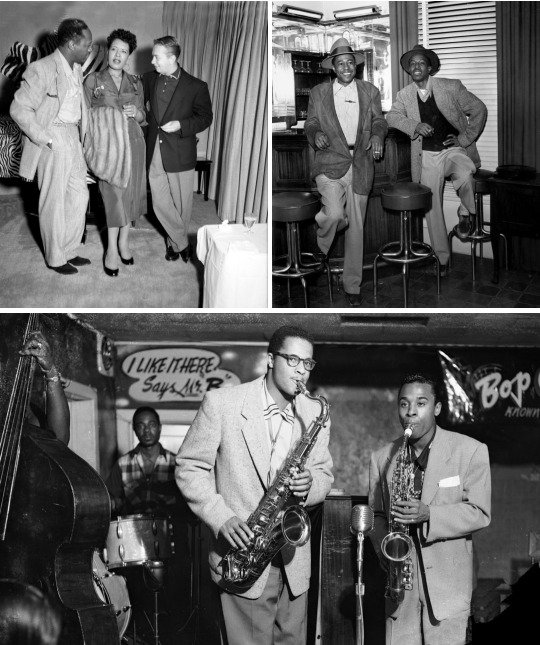

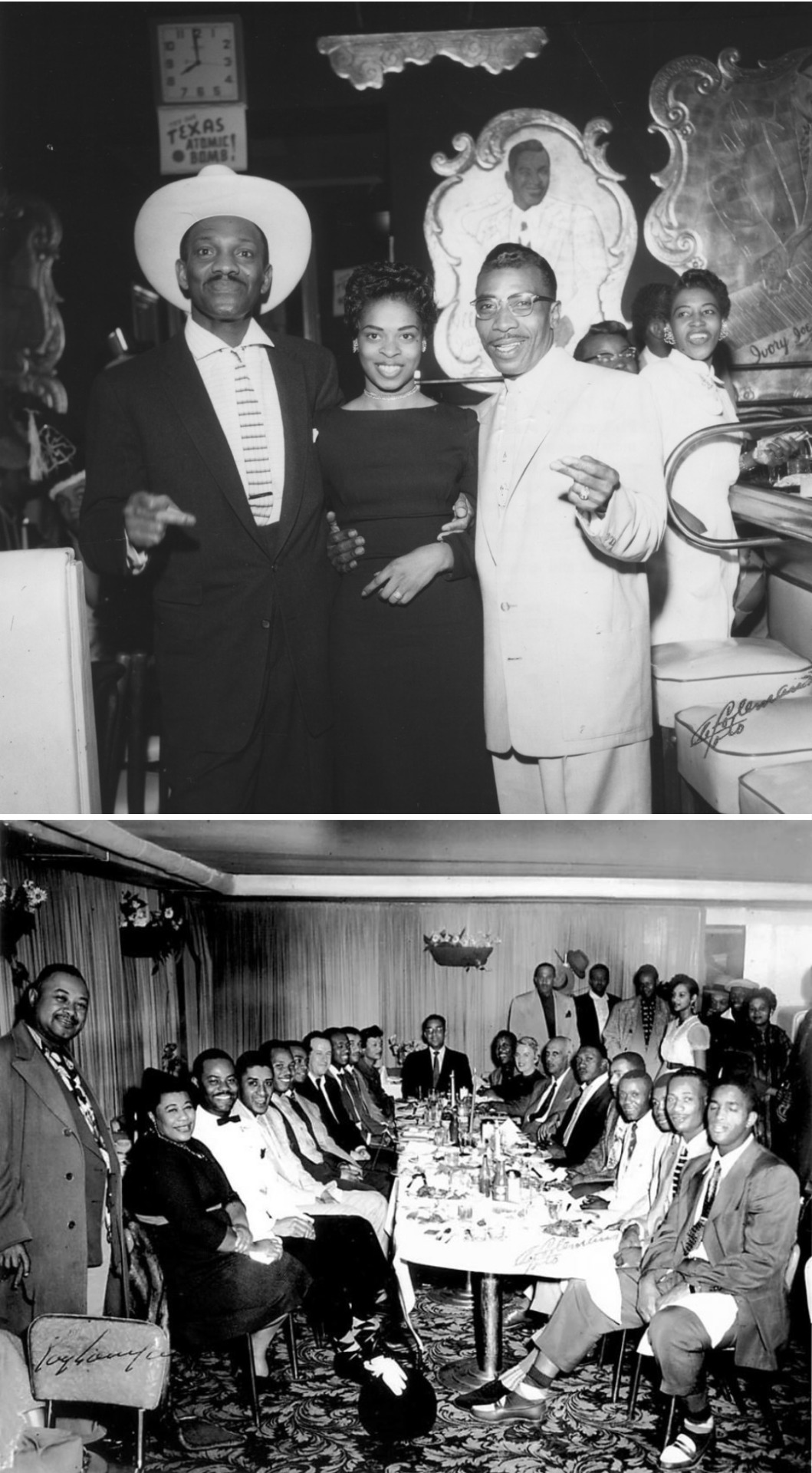

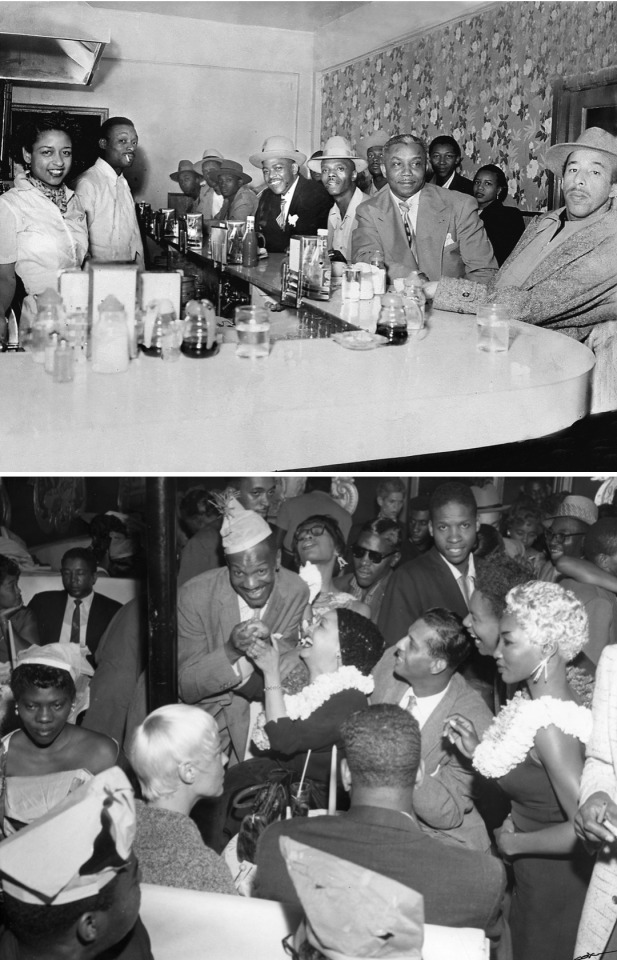

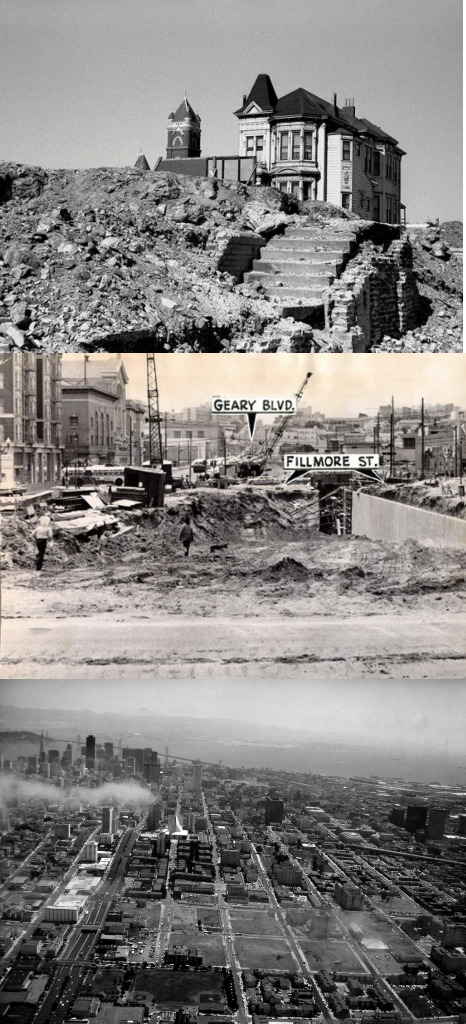
Fillmore District: ‘Harlem of the West’ - The Glory Days of the San Francisco Jazz Scene
San Francisco’s Fillmore District used to be one of the hottest nightlife spots in the country. Hip as jazz, cool as the blues, sexy like the R&B music bursting from its bars and clubs, the ‘Mo was the place to be in the 1940s and 50s. Duke Ellington? Check. Ella? Yup. T-Bone Walker? He was a regular at the Texas Playhouse on Fillmore and Sutter. The neighborhood was a bastion of Black culture on the west coast. Like NYC’s Harlem, where a renaissance of Black music and art had emerged in the 1920s, the Fillmore showcased a cultural utopia by and for African Americans two decades later.
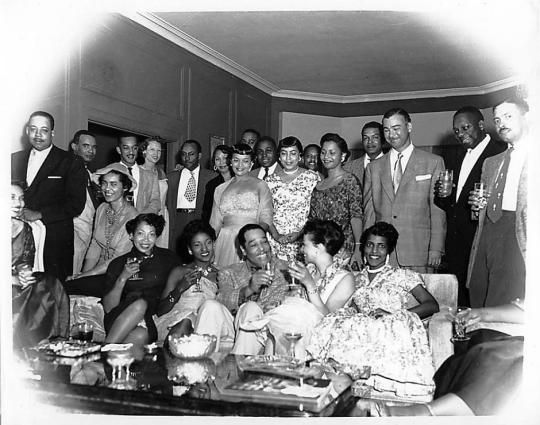
“Music in the Fillmore was organic. In the air. It was from the community and belonged to the community. You can’t look at the neighborhood without looking at the music that was coming from the people who lived there.”
— Wayne Wallace, musician
During World War II, the Fillmore became a hub for thousands of southern transplants lured to the Bay Area by the promise of jobs in the Kaiser shipyards across the bay in Richmond. They joined an already sizable community of Black San Franciscans and ethnic Japanese who’d decamped from Chinatown to the area near Geary and Fillmore Streets after the 1906 earthquake. In 1942, when the entire population of Japan Town was effectively evicted by forced internment, Black southerners took their place in the quickly crowding city. Young people with good jobs meant money to spend on fun, and the Fillmore’s already established entertainment sector took off like wildfire. Before long, the street was a blitz of nightclubs and late night eateries, record shops and shoe stores catering to the growing post-war middle class.
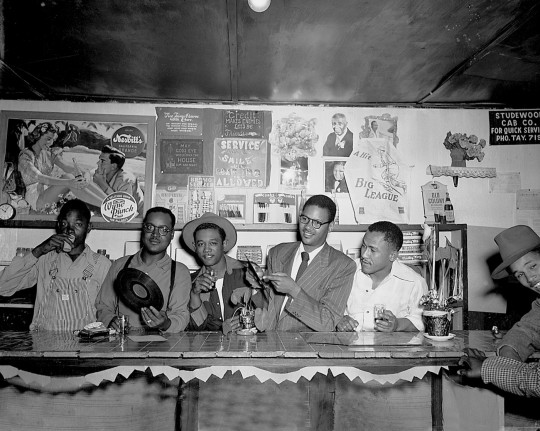
“Walking down Fillmore Street with my friends was so cool. There were movie theaters. Soul food restaurants. Pool halls. A bowling alley and a roller skating rink. You walked by different doorways, and you started to hear doo-wop. In the middle of the afternoon, these guys are cutting it up, singing in the doorway because the marble floor gives a better sound.”
— Steve Nakajo
In 1953, the Western Addition Project would begin by transforming two-lane Geary Street into a wider boulevard in an effort to ease movement to and from the city’s Richmond district. Eventually the project would subsume hundreds of city blocks in the neighborhoods west of City Hall, uprooting thousands of residents and turning what had been one of post-earthquake San Francisco’s main commercial districts into a veritable ghost town. By the late 1960s, all but a few of the great Fillmore music clubs were gone.
“The entertainment world for African Americans virtually ceased to exist in San Francisco. The great life that was Harlem-ish was destroyed by the redevelopment process. It was a blow to African Americans, a blow from which we frankly have never really recovered.”
—Willie Brown, former mayor of San Francisco
Source
A Brief History of Black San Francisco
San Francisco's reputation as one of America's most ethnically diverse cities is in question as its African Americans population erodes. In 1990, 11% of city residents were Black. Now that number is just 6% and is expected to drop below 4% by 2020.
Black San Francisco's numbers were low until the early 1940s, when workers began coming to work in the city's shipyards from places like Louisiana, Texas, and Arkansas. Before the 1940s surge, Black San Francisco's numbers were so low that there was a running joke that if you were Black, you probably knew all the Black folks in the city.

Newcomers from the South replaced Japanese Americans who were forcibly interned during World War II. After the war ended, the city's Black population continued to climb as workers remained in the city and developed roots. But the city's newcomers were limited in where they could live due to discriminatory housing policy and restrictive covenants written into property titles that did not allow African Americans the chance to live in other parts of the city.

The Fillmore District became Black San Francisco's cultural and economic heart. It became known as the "Harlem of the West," as all of the era's major artists performed in the neighborhood's venues. The list includes Count Basie, Etta James, Thelonious Monk, and Duke Ellington. But the Fillmore began changing after the war ended as federal redevelopment projects demolished many of the neighborhood's homes and businesses. Many residents relocated to Bayview and Hunters Point.
Restrictive covenants were outlawed under the Fair Housing Act of 1968, but by this point there were few incentives for Black Americans to stick around San Francisco, and many moved out to Oakland where a Black middle class came to flourish.
Some of those who stayed in San Francisco fought for better living and employment standards. An important group of activists during this period was the Big Five: five women activists who demanded more resources for Bayview and Hunters Point from city officials. One member of the group was Eloise Westbrook.
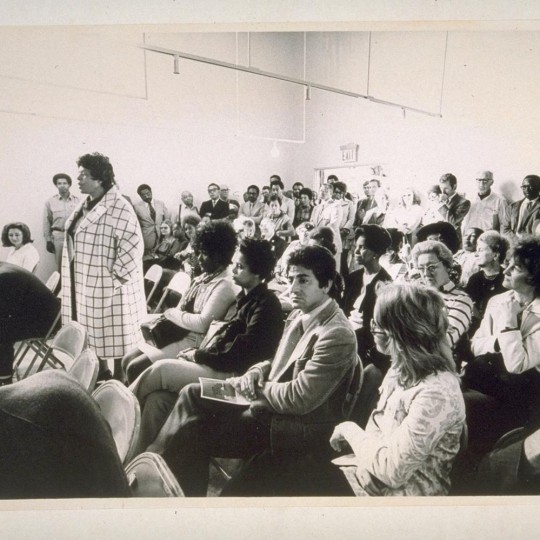
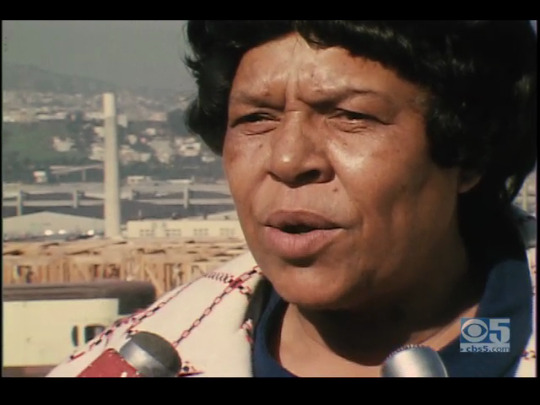
Read more
The Queen of San Francisco: Leola King and the “Harlem of the West”
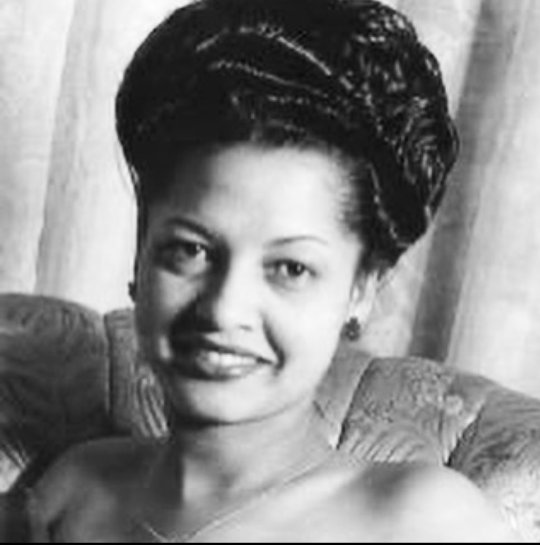
Once upon a time, San Francisco had its own Harlem, and this Harlem had a queen. A “fast-talking,” “show-me-what-you-can-do” woman, one-part glamour and a million parts grit. Her name was Leola King and she got her start running a barbeque pit at 1601 Geary Street. An homage to King’s native Oklahoma, it was built out of a log cabin and featured a fifty-foot smoke pit. The menu included smoked buffalo, deer, and quail.
How popular was Oklahoma King’s? Judging from the swanky Scott Street mansion Leola King eventually bought herself, it wasn’t just popular, it was epic.

Leola King and her mother in her Scott Street mansion.
Then one day she turned up to open the restaurant and saw that Oklahoma King’s had been laid to waste. Turns out the San Francisco Redevelopment Agency was fed up with trying to get King to sell her property. The restaurant was one of countless homes and businesses bulldozed into oblivion by the “urban renewal” projects that decimated the Fillmore jazz scene and eventually drove out the City’s African American community.
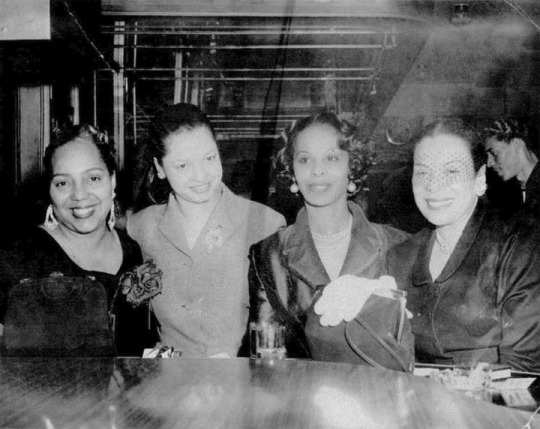
Leola King rallied—as phenomenal women will do. The Blue Mirror, King’s new club at 935 Fillmore Street, was small, but like its owner, it packed a mighty punch. Lena Horne, Ray Charles, Duke Ellington, Count Basie and Cab Calloway were just a few musicians that passed through King’s place. And Josephine Baker, Nat “King” Cole, Elizabeth Taylor and Sugar Ray Robinson? Oh, they were all her friends.

Josephine Baker, an unidentified man and Leola King
And then the San Francisco Redevelopment Agency came a second time. She built another jazz palace. That was stolen too. She built another one. Gone, like the rest. The last time, King refused to go quietly; she was forcibly removed by the sheriff. She spent the next quarter-century fighting for just compensation. She didn’t win, but when Leola King died in 2013, she died fighting.
Lance Burton, who grew up in the Fillmore and knew King in her heyday, wrote this about her in 2015: “Mrs. King was like a big movie star to many of us, a star who brought some very bright moments to our community—maybe the most golden period of years ever to have been seen in San Francisco.”
Source
Every time Black Americans would thrive and mind their business, here comes some bombs and/or urban renewal aka Negro removal.
#fillmore#fillmore district#fillmore jazz era#san francisco#bay area#harlem of the west#eloise westbrook#leola king#billie holiday#ella fitzgerald#josephine baker#lena horne#louis armstrong#duke ellington#1940s#1950s#black american history#black history
351 notes
·
View notes
Text
LoSlavery Is Not OUR "Original Sin" The thick lines show majority of African slaves went to Spain’s (they started trans-Atlantic slave trade) Latin American & Caribbean slave colonies, Muslim and African Countries. Few went to colony that became the US

How many times have you heard that slavery was “America’s original sin”? I’m not quite sure what that means, but I think the idea is that slavery was a uniquely horrible thing that defines the United States and will stain whites forever. It’s one of the few things Senate Minority Leader Mitch McConnell and Barack Obama agree on. There are books about it. Here’s a college course at UC Davis called “Slavery: America’s Original Sin: Part 1."
The fact is, there has been slavery in every period of history, and just about everywhere. The Greeks and Romans had it, the ancient Egyptians had it, it’s all over the Bible, the Chinese and the pre-Columbian Indians had it, the Maoris in New Zealand had it, and the Muslims had it in spades. But I have never, ever heard of slavery being anyone else’s “original sin.”
About the only societies that never had slaves were primitivehunter-gatherers. As soon as people have some kind of formal social organization, they start taking slaves.
You’ve heard about slavery and mass human sacrifices of Central and South American Indians, but North American Indians were enslaving each other long before the white man showed up.
Tlingit and Haida Indians, who lived in the Pacific Northwest, went raiding for slaves as far South as California. About one quarter of the population were slaves, and the children of slaves were slaves. During potlatches, or huge ceremonial feasts, the Tlingit would sometimes burn property and kill slaves, just to show how rich they were. What’s a couple of slaves to a guy who lives in a house like this?
When we bought Alaska from the Russians in 1867, Indians were furious when we told them they had to give up their slaves. The Tlingit carved this image of Abraham Lincoln, the emancipator, to try to shame the government into compensating them for slaves.
What were called the Five Civilized Tribes of the American Southeast happily bought black slaves. In 1860, there were 21,000 Cherokee, and they owned 4,000 slaves. And that was just the Cherokee. Many took their slaves with them when they were forced to move West.
Free blacks in the South owned slaves. The fact of having been slaves didn’t stop them from wanting to be slave masters themselves. In 1840, in South Carolina alone, there were 454 free blacks who owned a total of 2,357 slaves. Only about 20 percent of Southern households had even one slave, but 75 percent of the free-black households in South Carolina owned slaves.
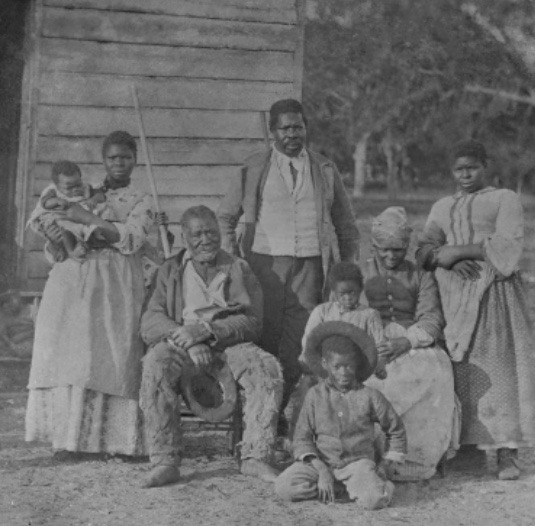

Don’t believe me? It’s all in this book by the expert on the subject, Larry Koger of the University of South Carolina. And he demolishes the idea that most blacks bought slaves only to get family members out of slavery. Like whites, some were kind masters and some were mean, but, for the most part, they owned slaves for exactly the same reasons whites did.

There’s a whole book about this black guy, Andrew Durnford.
He had a plantation of 672 acres along the Mississippi in Louisiana, and close to 100 slaves. Another black slave owner in Louisiana, P.C. Richards, owned 152 slaves. Black slaveowners avidly supported the Confederacy. There are no accurate estimates of the number of slaves held by free blacks at the time of the Civil War, but they would have been tens of thousands.
If slavery is somebody’s Original Sin, it’s sure not ours. Take a look at this map of the slave trade, beginning in 1500.

[Source: SlaveVoyages.com, click to enlarge]
The thicknesses of the lines represent numbers of slaves. What became the United States imported just around 400,000 slaves—about 3 percent of all the slaves who crossed the Atlantic. Look at all the slaves who went to Brazil and to the Caribbean Islands.They needed millions because, unlike American slaveowners who raised slave families, they bought grown men and worked them to death. And let us not forget, virtually every slave on this map was caught by blacks or Arabs.
And look at all the slaves who ended up in North Africa and the Middle East.
That’s millions of them going to Muslim countries at exactly the same time slaves were crossing the Atlantic. And Arabs had been taking black slaves out of Africa, across the Sahara, for 900 years before America was even discovered—and a forced march across the desert was a lot worse than crossing the Atlantic. In this article about Africa’s first slavers—the Arabs—historian Paul Lovejoy estimates that over the centuries, Muslims took about 14 million blacks out of Africa [Recalling Africa’s harrowing tale of its first slavers – The Arabs – as UK Slave Trade Abolition is commemorated, March 27, 2018]. That is more than the 12 million who went to the New World.
And you might ask, where are the descendants of all those Middle Eastern slaves? America has millions of slave descendants. Why don’t you see lots of blacks in Saudi Arabia or Syria or Iraq? Arabs castrated black slaves so they wouldn’t have descendants.

Muslims were even more enthusiastic about enslaving white people. Christian Slaves, Muslim Masters, by Prof. Robert C. Davis is the best book on the subject. Remember the Barbary Pirates of North Africa? Between 1530 and 1780 they caught and enslaved more than a million white, European Christians. During the 16th and 17th centuries, Arabs took more white slaves south across the Mediterranean than there were blacks shipped across the Atlantic.
Mostly, Muslim pirates captured European ships and stole their crews. In just three years, from 1606 to 1609, the British navy admitted it had lost 466 British merchant ships to North African pirates [Counting European Slaves on the Barbary Coast Past & Present, August 2001]. Four hundred sixty-six ships in just three years. Arabs took American slaves. Between 1785 and 1793 Algerians captured 13 American ships in the Mediterranean and enslaved the crews. This is a 1804 battle between Arab pirates and the USS Enterprise.

It was only in 1815, after two wars, that the United States was finally free of the Barbary pirates.
Muslim pirates also organized huge, amphibious slave-catching assaults that practically depopulated the Italian coast. In 1544, Algerian raiders took 7,000 slaves in the Bay of Naples in a single raid. This drove the price of slaves so low it was said you could “swap a Christian for an onion.”
After a 1566 raid on Granada in Spain netted 4,000 men women, and children, it was said to be “raining Christians in Algiers.” Women were easier to catch than men, and were prized as sex slaves, so some coastal areas lost their entire child-bearing populations. One raid as far away as Iceland brought back 400 white slaves.
Prof. Davis notes that the trade in black Africans was strictly business, but Muslims had a jihad-like enthusiasm for stealing Christians. It was revenge for the Crusades and for the reconquest of Spain from the Arabs in 1492. When Muslim corsairs raided Europe, they made a point of desecrating churches and stealing church bells. The metal was valuable but stealing church bells silenced the voice of Christianity.
It was a tradition to parade newly captured Europeans through the streets so people could jeer at them, while children threw garbage at them. At the slave market, both men and women were stripped naked to evaluate their sexual value. In the North African capitals—Tunis, Algiers, Tripoli—there was a big demand for homosexual sex-slaves. Other Europeans were worked to death on farms or building projects.
Prof. Davis writes that unlike in North America, there were no limits on cruelty: “There was no countervailing force to protect the slave from his master’s violence: no local anti-cruelty laws, no benign public opinion, and rarely any effective pressure from foreign states.” Slaves were not just property, they were infidels, and deserved whatever suffering a master meted out.
For a man, there was a fate even worse than being a sex slave. Hundreds of thousands became galley slaves, often on slave-catching pirate ships. They were chained to their oars 24 hours a day, and could move only to the hole where the oar went through the hull—so they could relieve themselves. If the men were rowing, they fouled themselves. Galley slaves lived in a horrible stench, ate rotten food, were whipped by slave drivers and tormented by rats and lice. They could not lie down and had to sleep at their oars. Many never left their ships, even in port. Their job was to row until they died, and to be tossed overboard at the first sign of weakness.
Muslims have taken slaves for as long as there have been Muslims, which is about 1,400 years.

Mohammed himself was an enthusiastic slave trader. Muslims still take black slaves. As this article points out, Libya still has slave markets, Mauritanian Arabs take black slaves, and there is still slavery in Niger, Mali, Chad and Sudan[Libya’s slave markets are a reminder that the exploitation of Africans never went away, by Martin Plaut, New Statesman, February 21, 2018].
And, of course, it was white people who abolished slavery, both in their own countries and, except for a few stubborn holdouts, the whole world. Africans, just like the Tlingit Indians, screamed about all the wealth we made them give up.
But slavery’s still our “original sin.” As Time magazine wrote just this month about slavery “Europeans and their colonial “descendants” in the United States engineered the most complete and enduring dehumanization of a people in history."[Facing America's History of Racism Requires Facing the Origins of 'Race' as a Concept, by Andrew Curran, July 10, 2020]
What a small minority of Americans did for 246 years—and in a relatively mild form—is worse than anything that was ever done anywhere by anyone.
That, ladies and gentlemen, is the power of white privilege. I hope you are enjoying it. Watch this video:
youtube
52 notes
·
View notes
Text
We attached tracking devices to West Africa’s green turtles. This is what we learnt

- By Ana Rita Patricio , Martin Beal , The Conversation -
Sea turtles have been swimming the world’s oceans and nesting on its beaches for over 120 million years. They even survived mass extinction events, including the one that saw the end of the large dinosaurs.
Throughout human history sea turtles have played key roles in the culture and diet of coastal populations around the world. But in modern times, over-exploitation of sea turtle meat, eggs, cartilage, oil, and body parts, caused population declines and even local extinctions. They also face threats from plastic ingestion and climate change.
Among the seven species of sea turtles, the green turtle was historically the most exploited for human consumption. Green turtles are a key element of West Africa’s biodiversity heritage and contribute to the health of coastal marine ecosystems in the region. But protecting them is difficult, in part because they perform some of the longest migrations known in the animal kingdom.
These grand movements pose a major conservation challenge: how do we protect animals that cross international borders and can therefore experience varying levels of protection and human-caused threats?
We conducted research around the small island of Poilão off the coast of Guinea-Bissau. The island is part of the Bijagós archipelago which hosts one of the largest green turtle populations in the world. The core nesting site for this population is Poilão island where around 25,000 turtles make their nests annually.

Researchers attaching satellite tags on a green turtle. French Connection films
In our recent study, we glued tracking devices to the shells of green turtles to study their movements. These devices transmitted their locations to orbiting satellites, allowing us to know where they are in near real-time.
We used the turtles’ positions to map the marine areas they occupy and estimate how much time they spent within marine protected areas.
We found that the green turtles from Poilão connect at least five West African nations. Some turtles remained year-round in the waters of Guinea-Bissau or nearby in Guinea, to the south. Others travelled some 400 km north to feed in Senegal and The Gambia, or even as far as 1000 km northwards to the Bay of Arguin, in Mauritania.

Feeding sites of West Africa green turtles. Usifo Omozokpea / Frontiers in marine science
We concluded from our findings that meeting the challenge of protecting the sea turtles calls for international cooperation for conservation coupled with an understanding of the geographic connectivity that they create.
The life-cycle of green turtles
When newly hatched green turtles emerge from the nest, they quickly crawl to the sea and soon disappear from sight.
They spend the first three to five years in the vast open ocean, after which they approach the coast to settle in areas rich in food.
For a green turtle, beds of seagrass and macroalgae are the typical habitats they seek for nourishment.
Female green turtles only reach adulthood at about 20 years old, at which point they return to lay their eggs on the same sandy beach where they emerged as hatchlings all those years ago.
After breeding, they return to their feeding grounds and take a much needed break from travelling, mating, making and laying eggs, which usually lasts about three years.
The beach at Poilão is patrolled by conservation teams during the peak of the nesting season (August to November), granting protection to the turtles that come ashore to nest. But turtles don’t stay long on the beach. Within two hours they have laid their eggs and returned to the sea.
Throughout the course of a breeding season, females lay between three and six clutches of eggs, at 12-day intervals, after which they migrate to their feeding grounds.
As green turtles are known to migrate sometimes thousands of kilometres between nesting and feeding areas, knowing their whereabouts is essential to assessing what threats they may face along the way. For example, if turtles were heavily captured for their meat at faraway feeding areas, the efforts in place on the nesting beaches of Poilão would be fruitless.
Studying the movements of turtles from the Bijagós Archipelago was therefore necessary to understand what level of protection the population has while at sea.
Revelations from satellite tracking
The research was conducted in partnership with biodiversity managers from Guinea-Bissau, Senegal and Mauritania, and provides a scientific basis for decision-making on effective conservation measures.
Based on the movements of the turtles, we were able to provide recommendations for conservation managers on how they could improve protection of important sites.
For example, we show for the first time that most of the coastal waters of the Bolama-Bijagós Biosphere Reserve in Guinea-Bissau are used as feeding grounds by this population. This is a strong argument for implementing fishing regulations in this reserve to reduce the risk of turtles being captured in fishing gear.

Poilão Island is a popular nesting place for green turtles. Miguel Varela
Our findings also show that the Regional Network of Marine Protected Areas of West Africa encompasses most of the habitats used by this important population. Turtles spent over 90% of their time inside the boundaries of the area during breeding, and 78% of their time when foraging.
However, we also identified locations, particularly during migration, where protection could be improved.
Our findings also have relevance for local communities in the region. For the Bijagós people it is a matter of pride that green turtles travel from so many different places to nest on their pristine beaches. Likewise, the Imraguen people, the sole residents of the Banc d’Arguin National Park, take pride in maintaining productive waters with vast seagrass beds, where green turtles can flourish.
Additionally, healthy sea turtle populations can promote eco-tourism through turtle watching activities, suggesting that the successful conservation of this globally important population may be economically beneficial to people across the region.

Ana Rita Patricio, Postdoctoral research fellow, University of Exeter and Martin Beal, Research Assistant, ISPA
This article is republished from The Conversation under a Creative Commons license. Read the original article.
--
Read Also
How we discovered that sea turtles in Seychelles have recovered from the brink
#turtle#sea turtle#turtles#animals#wildlife#zoology#oceanography#green turtle#biodiversity#africa#geography#wildlife conservation#geolocation#satellite
2 notes
·
View notes
Note
What type of cuisine do your OCs enjoy from the culture they're inspired from?
Hey! Sorry it took me a while to respond to this! I had to really think about some of these. The Trio has a post that goes into detail about their flavor palates and favorite dishes. It can be found right here!
As for my other ocs, I summed up their preferences below. I might make a separate post later going into more detail. I love talking about food, so thank you for asking!
The OCs I'll cover in this post: Sun Bai, the De La Vegas, Adrenaline, and Basil.
First off, I do allow real world regions to inspire my interpretation of different parts of the Arcana universe. It makes more sense if I explain that a little before moving onto the food so I'll just very quickly go through those:
Bulan Mountains - this is where Bai is originally from. I imagine the Northern Bulan territories to reflect the mountainous regions in China, while Southern Bulan is modeled after Vietnam. Bai's original family group was nomadic, so he's been all over. However, he has spent most of his formative years in the South. So naturally, he cuturally identifies more with Southern Bulan.
Catclaw Desert / Nopal / Esmeralda - Okay. These are the regions where the De La Vegas can trace their origins. I imagine Catclaw and Nopal to be very heavily shaped by Mexican and historically speaking, Mesoamerican influences. Esmeralda, which is the name I gave to the area located on the Southwestern coast of the Emerald Sea is modeled after the Philippines. Now, with that being said, there are A LOT of ethnic groups in the Philippines. The De La Vegas would have drawn inspiration from the Mexican immigrants that settled in the Philippines between 1565-1821. I thought this made the most sense since Nopal/Catclaw is just west of the region by the southwestern coast of the Emerald Sea according to the Arcana map. In my fics featuring the De La Vegas, you will see their language referred to as Esmeraldi - the language spoken by inhabitants of Esmeralda (the region that borders the Emerald Sea). Once again, Esmeraldi is modeled after Tagalog (the national language of the Philippines).
**When it comes to Basil and Adrenaline, I don't really have areas on the Arcana map that I can trace them back to. Adrenaline does not come from the Arcana universe. She's from my own universe that I made years ago, which has origins in Brazil, the Caribbean, Ancient Rome, and East Asia. When it comes to Basil, he is straight up Greek. I've seen people hc Nevivon as a Greece / or vaguely Mediterranean-inspired region, but I haven't thought about it enough about it that way to solidify any sentiment on that.
Now On to the Food!!! (below the cut for the sake of your dash)
Sun Bai - His favorite dish is salt and pepper squid, which is seasoned, breaded and fried. The way Bai likes his meat and vegetables prepared is what you would typically see in an authentic Vietnamese setting. This includes lemongrass pork, beef, and chicken. Cucumbers, carrots, cilantro, lime, basil, etc. Transparent rice noodles (such as vermicelli) as opposed to thicker, opaque noodles (like egg or udon). Though most of the food Bai enjoys eating is Viet-inspired, his favorite (s&p squid) is traditionally-speaking a Chinese dish. (And I say that because he'll eat calamari in any context as long as it's fried, but when he wants it to taste like home, he starts to get picky on the authenticity of the preparation.)
Mestra Adrenaline - Nali used to be a street performer when she was very young. Eventually, she honed her talents well enough to earn her a spot in the halls of reigning clan leaders, but until then, she was living/surviving in the urban jungle. One of her favorite dishes is acarajé - an originally West African dish (can also be found in Nigeria and Ghana) from the Bahia (northeastern) region of Brazil. Adrenaline's go-to spots to eat are the BBQ carts for espetinho. She's not picky about the origins of the cultural influence or the meat. Basically, if it's on a stick and covered in any style of bbq sauce, she's a happy camper. For Nali's sweet/snack tooth, she is very serious about her nuts. Candied, salted, paçoca - she takes them all ways, all day.
Basil Jebeles - Like I said earlier, Basil is ethnically Greek and does enjoy lots of the traditional family-style Greek dishes. His absolute favorite is pastitio, a casserole/lasagna-like dish with lots of yummy layers. He wants everyone to know that he prefers his baked without the cinnamon, thank you! He also loves the individually rolled spanakopita triangles and will munch on those all day if they’re left out for the taking. His favorite meze is taramasalata and pita bread. Basil’s got some healthy, strong forearms, which he will put to work to get that cod roe whipped to perfection!
#this wasn't an ask#it was an assignment!#that's ok tho i loved working on it#thank you!#oc lore#sun bai the psychic#mestra adrenaline#sascha the gunslinger#solo the seamstress#basil jebeles#the de la vegas#food lore
9 notes
·
View notes
Text
Events 4.20 (after 1920)
1922 – The Soviet government creates South Ossetian Autonomous Oblast within Georgian SSR. 1945 – World War II: U.S. troops capture Leipzig, Germany, only to later cede the city to the Soviet Union. 1945 – World War II: Führerbunker: On his 56th birthday Adolf Hitler makes his last trip to the surface to award Iron Crosses to boy soldiers of the Hitler Youth. 1945 – Twenty Jewish children used in medical experiments at Neuengamme are killed in the basement of the Bullenhuser Damm school. 1946 – The League of Nations officially dissolves, giving most of its power to the United Nations. 1961 – Cold War: Failure of the Bay of Pigs Invasion of US-backed Cuban exiles against Cuba. 1968 – English politician Enoch Powell makes his controversial "Rivers of Blood" speech. 1968 – South African Airways Flight 228 crashes near the Hosea Kutako International Airport in South West Africa (now Namibia), killing 123 people. 1972 – Apollo program: Apollo 16 Lunar Module, commanded by John Young and piloted by Charles Duke, lands on the Moon. 1998 – Air France Flight 422 crashes after taking off from El Dorado International Airport in Bogotá, Colombia, killing all 53 people on board. 1999 – Columbine High School massacre: Eric Harris and Dylan Klebold kill 13 people and injure 24 others before committing suicide at Columbine High School in Columbine, Colorado. 2007 – Johnson Space Center shooting: William Phillips barricades himself with a handgun in NASA's Johnson Space Center in Houston, Texas before killing a male hostage and himself. 2008 – Danica Patrick wins the Indy Japan 300 becoming the first female driver in history to win an Indy car race. 2010 – The Deepwater Horizon drilling rig explodes in the Gulf of Mexico, killing eleven workers and beginning an oil spill that would last six months. 2012 – One hundred twenty-seven people are killed when a plane crashes in a residential area near the Benazir Bhutto International Airport near Islamabad, Pakistan. 2013 – A 6.6-magnitude earthquake strikes Lushan County, Ya'an, in China's Sichuan province, killing more than 150 people and injuring thousands. 2015 – Ten people are killed in a bomb attack on a convoy carrying food supplies to a United Nations compound in Garowe in the Somali region of Puntland. 2020 – For the first time in history, oil prices drop below zero, an effect of the 2020 Russia-Saudi Arabia oil price war. 2021 – State of Minnesota v. Derek Michael Chauvin: Derek Chauvin is found guilty of all charges in the murder of George Floyd by the Fourth Judicial District Court of Minnesota. 2023 – SpaceX's Starship rocket, the largest and most powerful rocket ever built, launches for the first time. It explodes 4 minutes into flight.
0 notes
Link
[NOTE: we changed the bullets to numbers in order to help with readability of this relatively long post. there is no other purpose for the list numbering.]
Redistribute resources to support Black trans liberation and survival! Split a donation to all the orgs listed on this page OR allocate specific amounts to individual groups. Then be sure to share this page once you're done.
**All funds donated go directly to the groups listed via ActBlue. Feel free to reach out to them if you have any questions**
Last week, many people shared that it was hard to track down a centralized place to find a list of specifically Black trans groups. This page is part of an effort to create an easier way for people to find and donate specifically to Black trans work and people right now. We know that this list is not complete, and it will be continually updated. If you have questions or would like to add an org in your area to this page, please email: [email protected].
The groups listed in this first section only accept donations through PayPal, CashApp, or Venmo. Please support their important work by clicking over to their websites here:
Trans Sistas of Color Project Detroit: Exists to uplift, impact and influence that lives and welfare of transgender women of color in Detroit.
En-Poder-Arte (Colombia) Founded by an Afro-Colombian trans woman and other trans women of color. A few months ago, they launched a community house, which provides safe housing to Black trans women and trans women of color.
F2L Relief Fund: Provides commissary support (and legal representation & financial assistance) for incarcerated LGBTQ and Two-Spirit POC in NY State.
Middle Tennessee Black and Indigenous Support Fund: A community fund for Black and Indigenous queer and trans folks living and participating in rural Middle TN, with a goal to foster wealth redistribution in its larger community, direct the funds to Black and Indigenous community members, and build the leadership of Black and Indigenous community members.
Tournament Haus Fund: Mutual Aid fund for protestors and Trans/NonBinary BIPOC in the ballroom scene in Portland/Tacoma/Seattle.
TAKE Birmingham: A peer support group for trans women of color to come together and share their narratives. Also organizing around discrimination in the workplace, housing advocacy, & support for sex workers.
Black Excellence Collective Transport for Black NYC LGBTQ+ Protestors: Raising funds to provide safe transport for Black LGBTQ+ Protestors.
Kween Culture: Provides programming towards social and cultural empowerment of transgender women of color.
Black Trans Travel Fund : A mutual aid project developed to provide Black transgender women with the financial resources to self-determine safer alternatives to travel, so they feel less likely to experience verbal harassment or physical harm.
Heaux History Project: A documentary series and archival project exploring Black and Brown erotic labor history and the fight for sex workers’ rights.
Homeless Black Trans Women Fund: Supports Black Trans women that live in Atlanta and are sex workers and/or homeless.
Reproductive Justice Access Collective (ReJAC): A New Orleans network that aims to share information, resources, ideas, and human power to create and implement projects in our community that operate within the reproductive justice framework.
Rainbow Sunrise Mapambazuko/RSM (Democratic Republic of Congo): Fights for the Promotion of the rights and equality of LGBTQ people in DRC and is today facing this covid-19 crisis which further weakens Black LGBTQ people and more particularly transgender Black women.
Compiled direct donation links for individual Black Trans folks A compilation of direct donation links to Black trans people, including GoFundMes and CashApp handles. Email address on page to add to this list.
Below are the orgs you can support through the split donation form (on the right, if you're on a computer, or below if you're on a mobile device):
For The Gworls: This fund provides assistance to Black trans folks around travel to and from medical facilities, and co-pay assistance for prescriptions and (virtual) office visits.
Black Trans Fund: The first national fund in the country dedicated to uplifting and resourcing Black trans social justice leaders. BTF seeks to address the lack of funding for Black trans communities in the U.S. through direct grantmaking, capacity building support, and funder organizing to transform philanthropy.
Nationz Foundation: Provides education and information related to HIV prevention and overall health and wellness, while inspiring the community to take responsibility for their health while working towards a more inclusive Central Virginia for LGBTQIA+ identified individuals.
Trans Justice Funding Project: Supports grassroots trans justice groups run by and for trans people, focusing on organizing around racism, economic injustice, transmisogyny, ableism, immigration, and incarceration.
Third Wave Fund: An activist fund led by and for women of color, intersex, queer, and trans people under 35 years of age to resource the political power, well-being, and self determination of communities of color and low-income communities. Includes rapid response grantmaking, multi-year unrestricted grants, and the Sex Worker Giving Circle.
Unique Womens Coalition: The first Los Angeles based supportive organization for and by Transgender people of color, committed to fostering the next generation of black trans leadership from within community through mentorship, scholarship, and community care engagement work.
Black Trans Women Inc.: A national nonprofit organization committed to providing the trans-feminine community with programs and resources to help inspire individual growth and contributions to the greater good of society to meet its mission of uplifting the voice, heart and soul of black transwomen.
Black Trans Men Inc.: The first national nonprofit social advocacy organization with a specific focus on empowering African American transgender men by addressing multi-layered issues of injustice faced at the intersections of racial, sexual orientation, and gender identities.
SisTers/Brothers PGH: A transgender drop-in space, resource provider and shelter transitioning program based in Pittsburgh, PA.
Love Me Unlimited for Life: A catalyst that helps our transgender community members reach their goals and fulfill their potential through advocacy and outreach activities.
My Sistah's House Memphis: Designed to bring about social change within the Trans Community in Memphis, by providing a safe meeting space and living spaces for those who are most vulnerable in the LGBTQ+ community.
Black LGBTQIA Migrant Project: Builds and centers the power of Black LGBTQIA+ migrants through community-building, political education, direct services, and organizing across borders. BLMP is providing cash assistance to Black LGBTQ+ migrants and first generation people dealing with the impact of COVID-19.
Taja’s Coalition at St. James Infirmary: Empowers their community in navigating housing, medical services, legal services, and the workplace, as well as regularly training agencies in the SF Bay Area.
Marsha P. Johnson Institute: Helps employ black trans people, build more strategic campaigns, launch winning initiatives, and interrupt the people who are standing in the way of more being possible in the world for BLACK Trans people, and all people.
Black Trans Protestors Emergency Fund organized by Black Trans Femme in the Arts Collective : Supports Black trans protestors with resources like bail and medical care.
Black & Pink Bail Fund: A national prison abolitionist organization dedicated to dismantling the criminal punishment system and the harms caused to LGBTQ+ people and people living with HIV/AIDS who are affected by the system through advocacy, support, and organizing.
Black Visions Collective (MN): Black Visions Collective centers their work in healing and transformative justice principles and develops Minnesota’s emerging Black leadership, creating the conditions for long term success and transformation.
SNaPCo: A Black, trans-led, broad-based collaborative to restore an Atlanta where every person has the opportunity to grow and thrive without facing unfair barriers, especially from the criminal legal system.
Brave Space Alliance: Created to fill a gap in the organizing of and services to trans and gender-nonconforming people on the South and West Sides of Chicago, where very few LGBTQ advocacy networks exist.
Okra Project/Tony McDade and Nina Pop Mental Health Fund: Provides Black Trans people with quality mental health & therapy. Also addresses food security in Black trans communities.
House of GG: A nonprofit, founded by legendary trans activist Miss Major Griffin-Gracy, that is raising money to build a permanent home where Transgender people can come, feel safe, and be part of a growing network of Southern trans people who are working for social justice.
TGI Justice Project: TGI Justice Project is a group of transgender, gender variant and intersex people -- inside and outside of prisons, jails and detention centers -- challenging and ending human rights abuses committed against TGI people in California prisons, jails, detention centers and beyond.
Trans Women of Color Collective: TWOCC exists to create revolutionary change by uplifting the narratives, leadership, and lived experience of trans people of color.
Youth Breakout: BreakOUT! seeks to end the criminalization of lesbian, gay, bisexual, transgender, and questioning (LGBTQ) youth to build a safer and more just New Orleans, organizing with youth ages 13-25 who are directly impacted by the criminal justice system.
Translash: A trans-led project uses the power of individual stories to help save trans lives, shifting the cultural understanding of what it means to be transgender, especially during a time of social backlash, to foster inclusion and decrease anti-trans hostility.
TRANScending Barriers: A trans-led trans-issue focused organization whose mission is to empower the transgender and gender non-conforming community in Georgia through community organizing with leadership building, advocacy, and direct services.
My Sistah's House: A trans-led nonprofit providing first hand experience as well as field research to create a one-stop shop for finding doctors, social groups and safe spaces for the trans community, providing emergency shelter, access to sexual health services, and social services.
Dem Bois: A national organization with the mission to provide charitable economical aid for female to male, FTM, trans-masculine identified person(s) of color ages twenty-one years old and older for them to obtain chest reconstruction surgery, and or genital reassignment surgery in order to help them on their journey to live a more fulfilled physical, mental, and self-authentic life.
G.L.I.T.S: Approaches the health and rights crises faced by transgender sex workers holistically using harm reduction, human rights principles, economic and social justice, along with a commitment to empowerment and pride in finding solutions from our own community.
Emergency Release Fund: Aims to ensure that no trans person at risk in New York City jails remains in detention before trial; if cash bail is set for a trans person in New York City and no bars to release are in place, bail will be paid by the Emergency Release Fund.
HEARD: Helping Educate to Advance the Rights of Deaf Communities: Supports deaf, hard of hearing, deafblind, deafdisabled, and disabled (“deaf/disabled”) people at every stage of the criminal legal system process, up to and including during and after incarceration.
Black Trans Advocacy Coalition COVID-19 Community Response Grant: Works daily to end discrimination and inequities faced in health, employment, housing and education to improve the lived experience of transgender people.
Princess Janae Place: Provides referrals to housing for chronically homeless LGBTQ adults in the New York Tri-state area, with direct emphasis on Trans/GNC people of color.
The Transgender District: Aims to stabilize and economically empower the transgender community through ownership of homes, businesses, historic and cultural sites, and safe community spaces.
Assata’s Daughters: A Black woman-led, young person-directed organization rooted in the Black Radical Tradition. AD organizes young Black people in Chicago by providing them with political education, leadership development, mentorship, and revolutionary services.
Collective Action for Safe Spaces: A grassroots organization that uses comprehensive, community-based solutions through an intersectional lens to eliminate public gendered harassment and assault in the DC area.
The Knights and Orchids Society (TKO): Strives to build the power of the TLGB community for African Americans throughout rural areas in Alabama & across the south, to obtain our dream of justice and equality through group economics, education, leadership development, and organizing cultural work.
The Outlaw Project: Based on the principles of intersectionality to prioritize the leadership of people of color, transgender women, gender non-binary and migrants for sex worker rights in Phoenix, AZ. Ensuring our rights and health as a first step will ensure the rights and health of all sex workers.
WeCare TN: Supports trans women of color in Memphis, TN, through education, and empowerment, with the goal to ensure that transwomen of color have the same equity and quality of life as envisioned.
HEARD (Helping Educate to Advance the Rights of Deaf Communities): Supports deaf, hard of hearing, deafblind, deafdisabled, and disabled (“deaf/disabled”) people at every stage of the criminal legal system process, up to and including during and after incarceration.
Community Ele'te (Richmond, VA) To establish unity, provide safe sex awareness and education, linkage to resources, emergency housing assistance, and empower the community to make positive lifestyle decisions.
TAJA's Coalition: An organization dedicated to ending violence against Black Trans women and Trans women of color based in San Francisco
Black Trans Task Force: (BTTF) is an intersectional, multi-generational project of community building, research, and political action addressing the crisis of violence against Black Trans people in the Seattle-Tacoma area.
The Transgender District: Aims to stabilize and economically empower the transgender community through ownership of homes, businesses, historic and cultural sites, and safe community spaces.
Trans Sistas of Color Project Detroit: exists to uplift, impact and influence that lives and welfare of transgender women of color in Detroit.
Black Trans Media (Brooklyn, NY): We are #blacktranseverything storytellers, organizers, poets, healers, filmmakers, facilitators here to confront racism and transphobia trans people of the diaspora committed to decolonizing media and community education
Garden of Peace, Inc.(Pittsburgh, PA): Centers black trans & queer youth, elevates and empowers the narratives and lived experiences of black youth and their caretakers, and guides revolutionary spaces of healing and truth through art, education, and mentorship.
House of Pentacles (Durham, NC): HOP is a Film Training Program and Production House designed to launch Black trans youth (ages 18-35) into the film industry and tell stories woven at the intersection of being Black and Trans. We have a simple mission: to train the next generation of Black trans storytellers and filmmakers, to leverage our brand to get Black trans filmmakers paid projects in their communities, and to pay Black trans trainees to work on HOP projects that further the stories of Black trans people globally.
Minnesota Transgender Health Coalition (Minneapolis, MN): is committed to improving health care access and the quality of health care received by trans and gender non-conforming people through education, resources, and advocacy.
RARE Productions (Minneapolis, MN): Arts and entertainment media production company for LGBTQ people of color that promotes, produces, and co-creates opportunities and events utilizing innovative artistic methods and strategies.
Baltimore Safe Haven: providing opportunities for a higher quality of life for transgender people in Baltimore City living in survival mode.
Transgender Emergency Fund of Massachusetts: recently helped organize a Trans Resistance Vigil and March through Boston, in place of the Boston Pride Parade that was cancelled due to COVID-19.
Semillas: In Borikén/Puerto Rico, our trans, gender non-conforming and queer communities are facing many obstacles to our survival, and not only due to Mariá.
Street Youth Rise Up: Our campaign is to change the way Chicago sees and treats its homeless home free and street based youth who do what they have to do to survive.
Trans(forming): A membership-based organization led by trans men, intersex, gender non-conforming people of color, to provide resources and all around transitional support.
81 notes
·
View notes
Text
BOSTON BY CASEY AFFLECK
October 25, 2020 For the record, what follows is nostalgia, false memories, and generalizations. But it’s all true. I grew up in Cambridge, Massachusetts, across the Charles River from Boston proper. Cambridge was one of the most diverse, multicultural cities in America. It was a beautiful, colorful, vibrant place. People from all over the world lived there, all mixed-up together. It is the place I was born and will return to, God willing. It is the city with the smells and sounds and tastes and people I love the most. Despite how much I loved it, when I look at old photos, I often look like this:
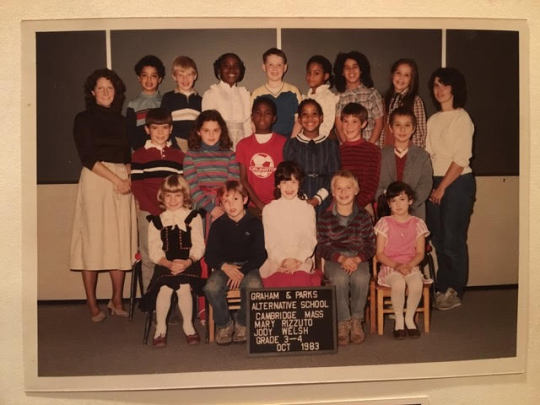
I’m in the front in the blue shirt. My best friend was Michael, the tall kid in the red shirt, whose family came from Barbados. Through the middle school years, anytime we weren’t in school we were roaming the streets like Dickensian urchins.
In the ‘90s, Cambridge got rid of rent control. Families who had lived there for four or five generations were squeezed out. Now the city is gentrified; but when I was growing up there, it was scrappy and beautiful. It was mostly working people, except for West Cambridge—where wealthy families lived, where professors lived. Where Cornel West, Yo-Yo Ma, and the Governor lived. East Cambridge was working-class Portuguese families, butcher shops, funeral parlors, and tow yards. Cambridgeport, where I lived, was mostly poor, Italian, Black, Greek, and Irish families. North Cambridge had some big housing projects and the school where my mom taught fifth grade—in a gigantic cement structure called The Tobin School that felt like it was far away because I would have to take a train AND a bus to get there. In reality, it’s like three miles from where we lived.
This is me hanging out in her classroom:
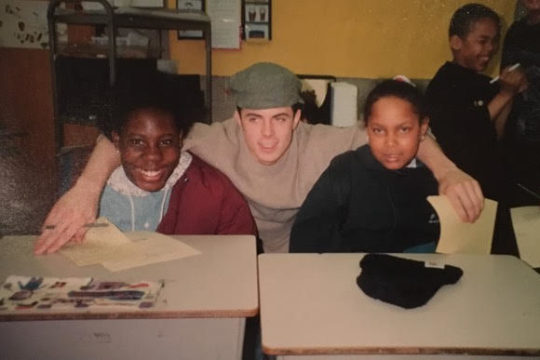
As people and places evolve, the past always reveals blemishes unseen at the time. However, Massachusetts manages, as time unfolds, to be a place that was so often on the right side. Not always, but often enough that I am proud to be from Cambridge, Massachusetts, no matter what.
From Massachusetts came the first national publication denouncing slavery, America’s “first feminist”, and The Cambridge Woman’s Suffrage League, which formed in 1886. My high school had the first girl to play tackle football in that division. Cambridge voted-in the first openly gay African-American mayor in our country. Right now our mayor is a very popular and forward-thinking Muslim woman who immigrated from Pakistan named Sumbul Siddiqui. We have marvels of architecture, science, and tech. It was in Cambridge that the very first email was ever sent (and received). And every year the Red Sox stand up to the wealthier bullies from the Bronx. These are all things we are immensely proud of, but nobody is resting on these laurels.
I am going to tell you about the places I remember fondly, whether they are still there or not.
Luckily, the city’s history isn’t going anywhere, and it hasn’t lost all of its charms. It is a place best seen by walking. So just walk. It’s also seasonal. Different activities for different seasons. But if you can hoof it for a few miles do this: start at the Old North Church and go by Paul Revere House, through Faneuil Hall, by The Old State House through Boston Common, through the Back Bay, go left and pass through Roxbury, another left, and go through South Boston till you hit the water and go left till you hit the Children’s Museum. Sit down and relax. If you just want a path, walk that. Map it or wander around. The city is full of little back streets with lots of character.
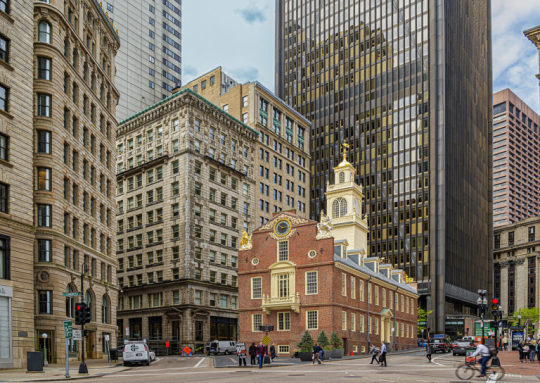
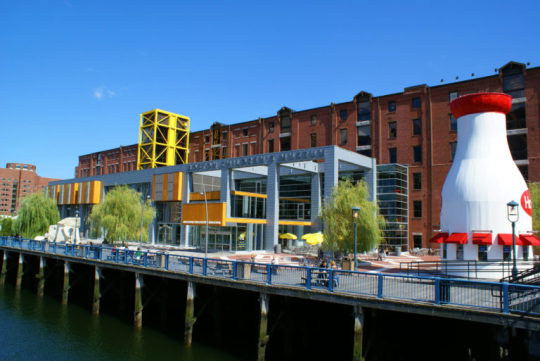
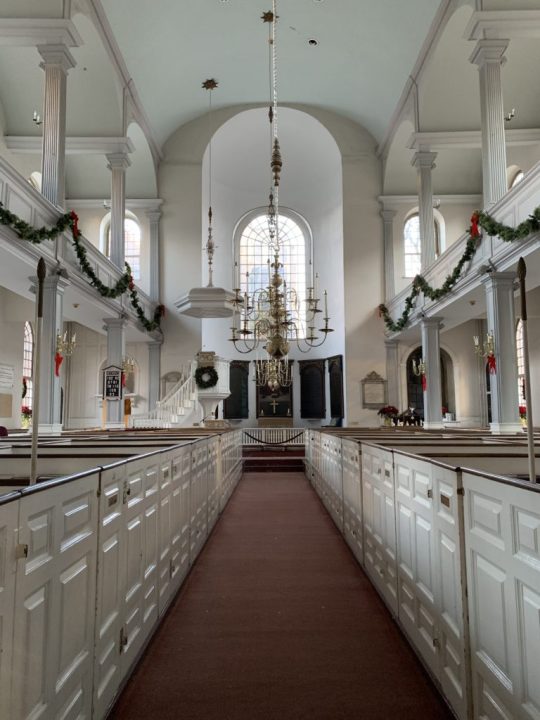
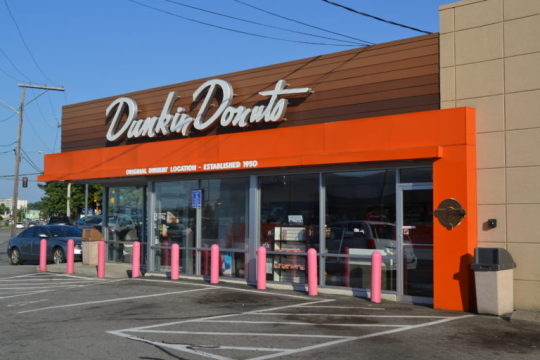
MY BOSTON FAVORITES
When looking for things to do and see in the area, you can ask ten people and get ten different answers. You will get a long list of historical buildings, or you will get names of some of the country’s prettiest parks, or you will get pointed toward the campuses of some of the very best schools in the world. But for every Bunker Hill, there are ten other places you haven’t heard of. So I am going to tell you about the places I remember fondly, whether they are still there or not. The thing about Boston is you can miss all the best stuff, and you will still leave thinking it is one of the best cities on Earth. Have fun.
Pinocchio Pizza, Harvard Square. I asked my son to describe it. He says, “the food is good but the vibe is fire, old school; whatever, just get a slice and sit on the ground. That’s why I like it.” I have no idea why he wants to sit on the ground, but I guess that’s part of the charm of the place. We’re both vegan so we both scrape the cheese off and eat bread and sauce. That should tell you something.
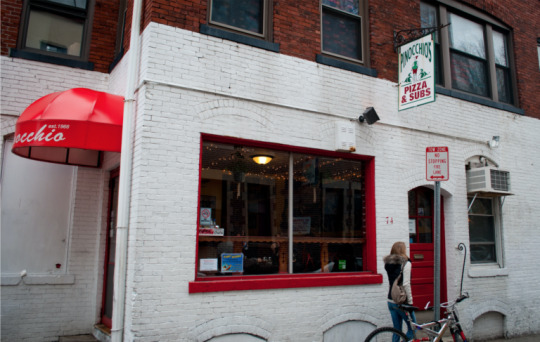
Oleana Restaurant on Hampshire Street in Cambridge. Chef Ana Sortun is a baller. The food is Turkish inspired, and it is delicious. Always. Friendly people, pretty inside, and it is in a nice residential neighborhood. My dad lived in an apartment a few blocks away behind a Store 24 until he was evicted back in 1989.
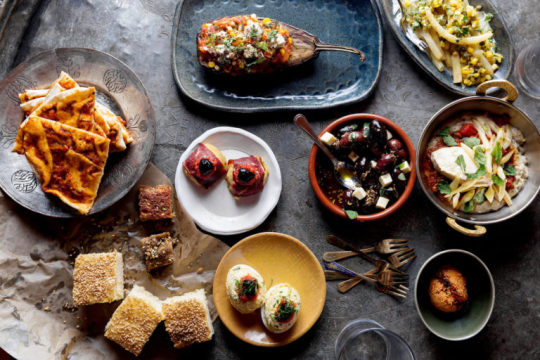
Maharaja, Harvard Square. Incredible Indian food. And it has one of the only third-story views of Harvard Square.
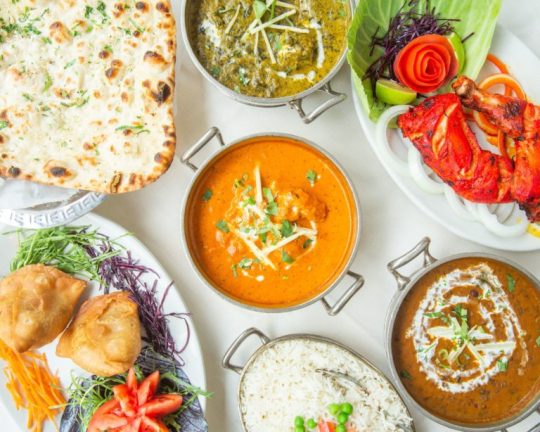
Veggie Galaxy is great diner food. It is vegan. It has breakfast, lunch, dinner, milkshakes and other deserts. All day and all night food that is filling and really good.

Life Alive Organic will serve you the healthiest and heartiest meal you can find anywhere. It’s across the street from City Hall, the post office, and the oldest YMCA in the country.
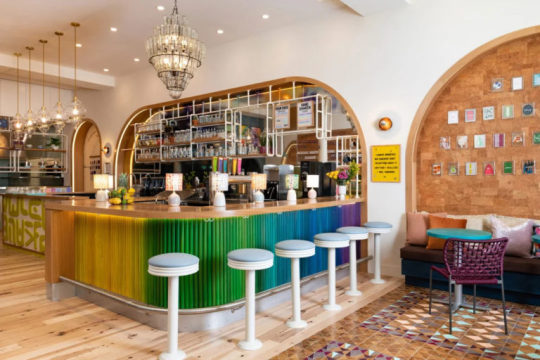
Cantab Lounge, where my dad was a bartender, and then a janitor when he was too drunk to be a bartender. I drank six thousand ginger ales, sitting in the corner at a sticky table while he worked. Forever it was a bar for postal workers that opened at 10 am, where alcoholics ate hard-boiled eggs from jars that had been sitting on the bar top for two weeks. A couple of days after initially writing this, I got an email from the owner. It is being sold after tens of thousands of years. I don’t know why I care because I don’t exactly have any fond memories from the place, but seeing the brick-and-mortar of your childhood torn down is a kind of mid-life, coming-of-age moment. Life is change.

Darwins Ltd coffee shop and attached mini-grocer and sandwich spot. If you get a coffee and then walk west two blocks on Mt. Auburn St. you will discover on your right a nice little park with a fountain to hang out. It is called Longfellow Park. Or you can look to your left and you will see the Charles River, and you can stroll there.
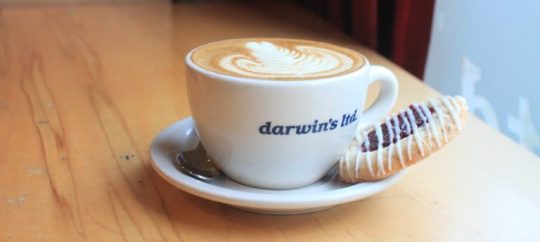
Fomu for dessert.
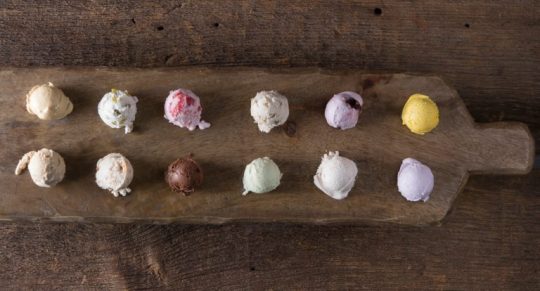
Zhu Pan Asian Cuisine and True Bistro for good vegan food.
Newbury Comics is famous and cool.
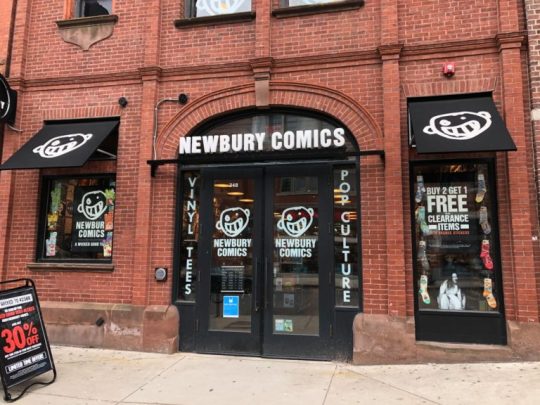
Million Year Picnic is for comic connoisseurs. They are both great. And they were both plagued by roving bands of middle school thieves in my day. The most notorious was named Mathew Maher. He is now a well-known theater actor on Broadway and appeared in the comic book movie Captain Marvel. But back then he stole shit.
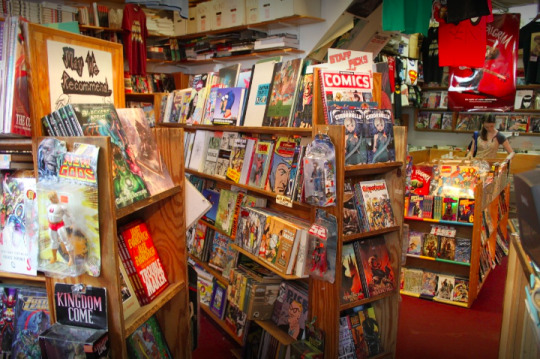
Harvard Coop is the best place to browse for books. Especially the kids section. We spend hours there and nobody kicks us out.

After the game ended everyone would come out and buy sausages [from me] on their way home, then I would clean up and go into a bar outside the park, where my boss was drinking and I’d wait till he was done so I could get a ride home. I was 12 years old. A couple of years ago I threw out the first pitch. Life is change.
The Isabella Stewart Gardner Museum is my favorite museum in town, maybe anywhere. It was once her home and it features an indoor garden that is perfect. It also has a great collection of art from around the world. Back on March 18, 1990, two famous paintings were stolen from the museum. As I remember it, a couple of guys showed up in the morning in police uniforms and the guard let them in. They tied the guard up and took a dozen paintings—Vermeer, Rembrandt, Degas—and vanished. The FBI never found them and never found the art. There are two plaques below two empty spaces on the walls to this day. On some days, classical musicians perform in random rooms while you walk around. You won’t want to leave.
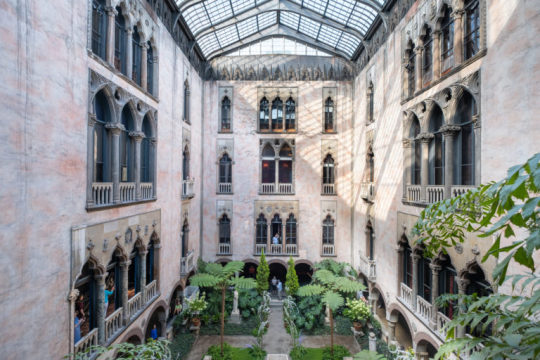
Fenway Park. Greatest professional sports arena of any kind. I used to sell sausages in front of the Cask ‘N Flagon, a bar behind The Green Monster.

It is the best baseball bar in the country. When everyone was in the park watching the game, and there was nobody buying food, I would go in and find a seat and watch the game with whoever I was working with; I have seen hundreds of games from every part of the park. After the game ended everyone would come out and buy sausages on their way home, then I would clean up and go into a bar outside the park, where my boss was drinking and I’d wait till he was done so I could get a ride home. I was 12 years old. A couple of years ago I threw out the first pitch. Life is change.
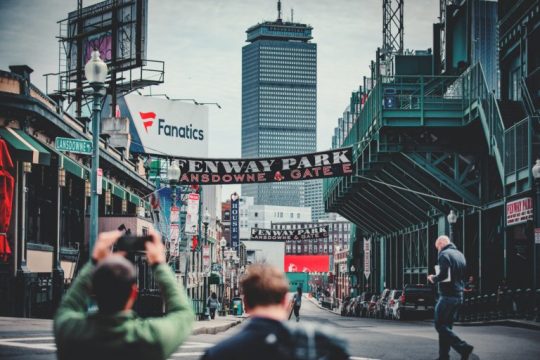
Plimoth Plantation is a living museum in Plymouth, which is 40 minutes from Boston. It is amazing. The actors working there are some of the best I have seen anywhere. If you are even mildly interested in history you have to go there.

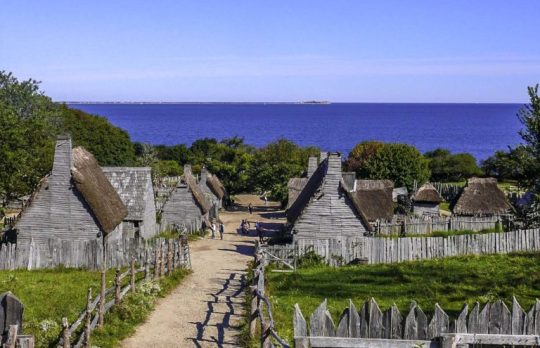
Fresh Pond is where you can go running or biking. Two and a half-mile loop.
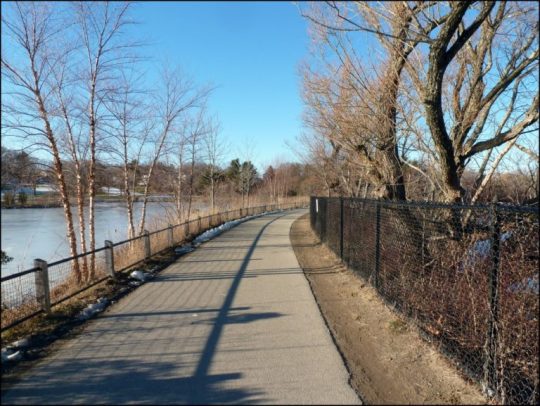
Or you could hit The Emerald Necklace which is a great run that hits many of the best green areas, Franklin Park included. When we were young we would hop the fence and swim in the water. That isn’t done anymore ever, and everyone has grown up and leading better, more responsible lives.
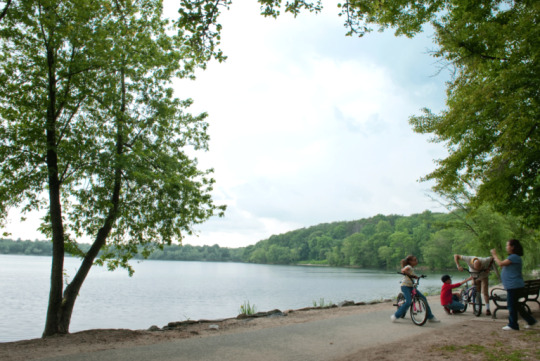
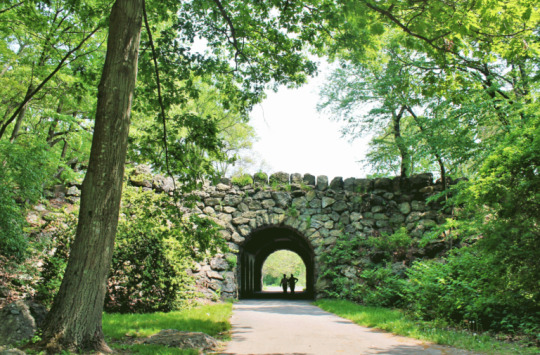
John Weeks Footbridge is a very pretty, very old, brick walking bridge that spans the Charles River. Watching the Charles Regatta from here is awesome. That is in the Fall. But it’s also great any night.
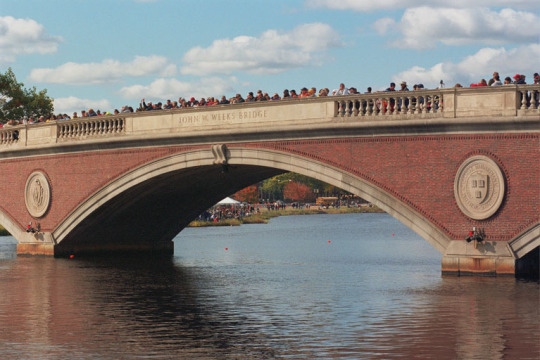

The King School is a grade school not too far from there. It has maybe the best playground in the city. If you are there in the summer you can just walk on. When I was a kid, the King School is where a girl went who I was head over heels in love with. I finally got a shot at winning her heart in my early twenties and blew it.
Mount Auburn Cemetery is beautiful if you like that kind of thing. Lots of cool people are buried there, and the trees and stones are really nice. It’s a maze but just walk uphill. You will reach a monument with a great view of the city.
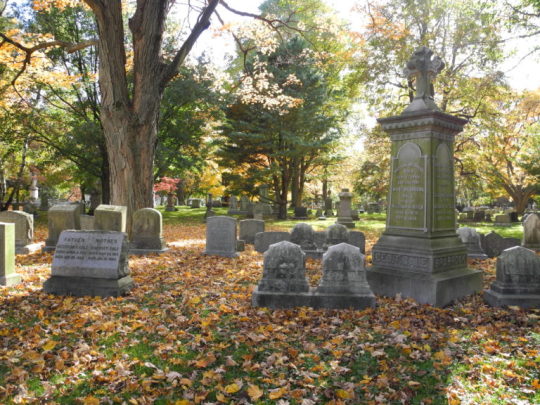
The American Repertory Theater puts on good plays. I grew up going there cause a friend of my mother’s directed many of the shows and could sneak us in the back. I wasn’t the adult making that decision; had I known better I would have scraped together the ticket price and supported the arts.

Boston Common is beautiful but you have to avoid all the shopping around it. If you have to shop go to:

NOMAD on Mass Ave in Cambridge is a store that you shouldn’t miss. In a world lost to chain stores and general homogenization of everything, Nomad is the real deal. Deb Colburn has been curating this place since I was ten. It is her store, and she has been trying to wake people up to folk art from around the world since Reagan was in office.
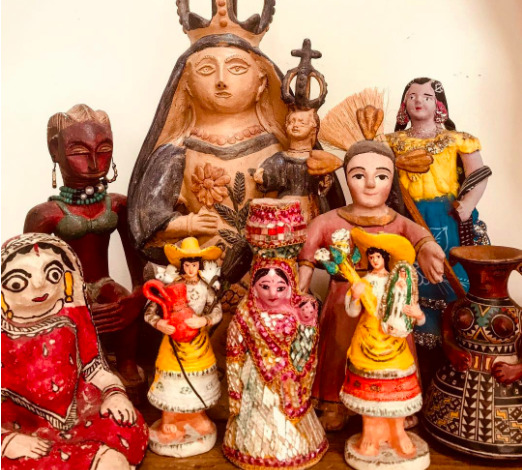
Bodega is a hidden high-end sneaker and casual wear store that must be entered through an unmarked door inside a bodega on a nearby side street. It’s cool how they have done it. Great presentation. Kids will like it.
KIDS ACTIVITIES
There are lots of things you can force your kids to do—things they won’t like the sound of at first, but will ultimately enjoy.

IMAGE CAPTIONS, LEFT TO RIGHT
On a rainy day, hop on the T and ride around town all day reading comics. Then stand outside in the warm rain (kids from LA don’t get this much).
Looking at murals. Cambridge has great murals everywhere. They are old and, incredibly, not vandalized. This one has been on this wall near the river since I was a kid. The child is mine and he is sick of walking around Cambridge.
If you feel like a pilgrim hit the gift shop at Plimoth Plantation.
Playing chess at Leavitt & Pierce Tobacco. You can inhale the scent of pipe tobacco without smoking it, and rent a chess set, clock, and table for $2 an hour in a beautiful old, wood-paneled shop with great ambiance.
Going to the oldest YMCA in the country.
Kayaking on the Charles River. You can get your kayak on Soldiers Field Rd. Take it east under all the bridges until you get to the inlet at Kendell Sq. It will all be clear. It will take about an hour.
Climbing the stairs at Harvard Football Stadium.
Reading books at the Harvard Coop.



NEARBY BOSTON
If you wanna go a little farther, go out to Gloucester for the day. Swim, eat, walk around, go back.
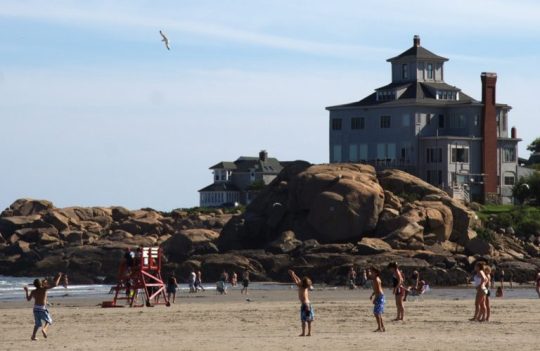
Whale watching sounds like a lame tourist trap but seeing whales up close will change the way you think about life on Earth.
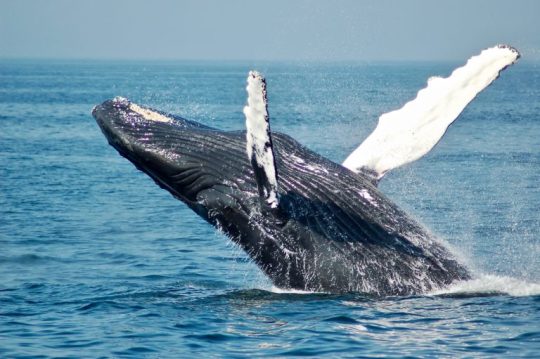
You can take the ferry from Downtown Boston to Provincetown. It is a great place to visit or stay a few days while in town. Ptown is the eastern-most point on the continent. I might be making that up, but it’s close. It’s an arm that sticks out into the Atlantic. It’s really lovely there with a great vibe all around. You can’t have a bad time and everyone is super happy to be there. The beaches are all beautiful. Sharks mostly only eat the seals and won’t come any closer to shore than two feet—but if you want to see a great white up close, we can make that happen.
Cape Cod has some great flea markets. If you plan on spending time on vacation with your family you can find some essentials, like a medieval battle helmet, at the flea market.
SALEM, MASSACHUSETTS
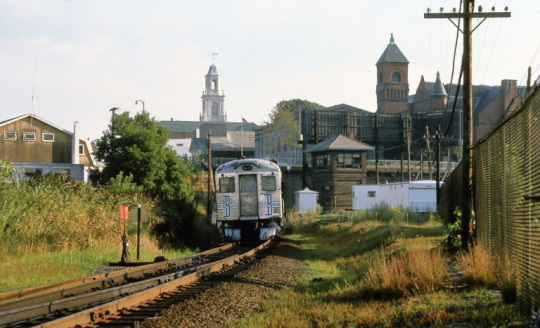
30 minutes on the local train line from downtown. Made famous by the Salem witch trials; a fun place to visit and walk around for about 128 minutes. Newburyport and Rockport lines, which depart from Boston’s North Station, stop at the Salem station. You can go into the homes of people who lived during the witch hunt.
The House of the Seven Gables, made famous by American author Nathaniel Hawthorne‘s novel The House of the Seven Gables, is a 1668 colonial mansion in Salem, Massachusetts named for its gables. The house is now a non-profit museum, with an admission fee charged for tours, as well as an active settlement house with programs for children. It was built for Captain John Turner and stayed with the family for three generations.
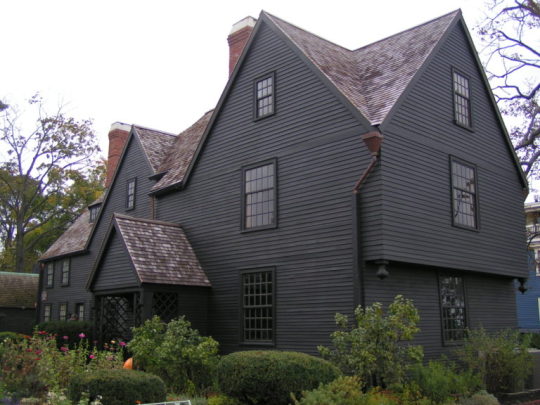
The Jonathan Corwin House in Salem, Massachusetts, known as The Witch House, was the home of Judge Jonathan Corwin. It is the only structure still standing in Salem with direct ties to the Salem witch trials of 1692, thought to be built between 1620 and 1642. Corwin bought it in 1675 when he was 35, and he lived there for more than 40 years. The house remained in the Corwin family until the mid-19th century and is located in the McIntire Historic District.
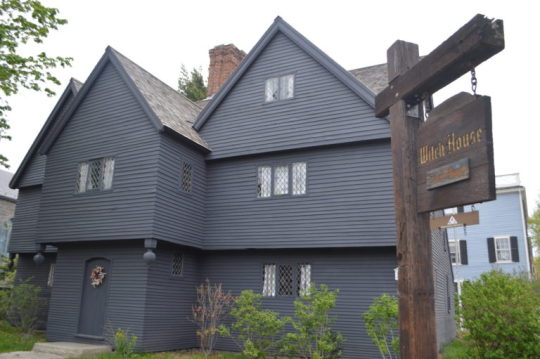
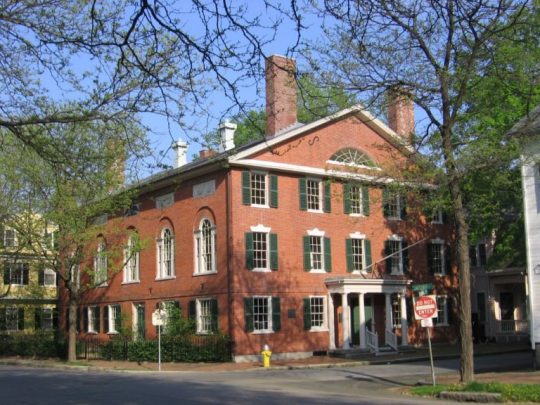
A MECCA FOR ARTISTS
Lastly, for centuries, Cambridge has been a mecca for artists, especially writers. Here are some spots to see if you like that kind of thing:
The corner of JFK Street and 1390 Massachusetts Avenue. This is a good spot. Here is why: America’s FIRST PUBLISHED POET was a woman named Anne Bradstreet who died in 1672 and lived on this spot! It went through lots of changes, and 300 years later, by the time I was walking around, it became a great burger place called THE TASTY. In 1996 or whatever, The Tasty appears in the movie Good Will Hunting in the scene when Matt Damon kisses Minnie Driver. It might have also appeared in the film Love Story back in the 70s. I mix them up. Now it is a CVS. God help us.
The Longfellow House. Henry Wadsworth Longfellow lived at 105 Brattle Street. The great poet taught at Harvard and lived in the Georgian mansion from 1837 until his death in 1882. Before the author, George Washington used the house as his headquarters during the Siege of Boston. The house is open to the public, and it is where I had my eighth-grade graduation ceremony. The mayor attended and forgot the name of our school in his address to the kids. I heard people mutter that he was drunk. I can’t blame him. I had my first drinks hours before that ceremony.
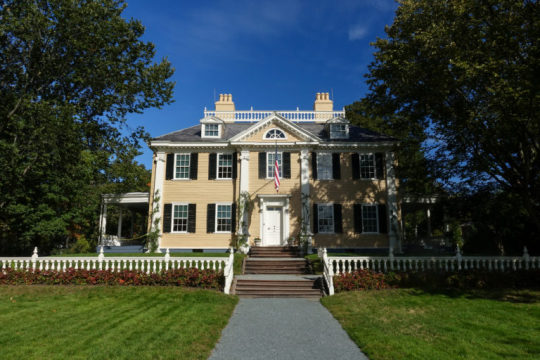
71 Cherry Street, Cambridge. The woman considered to be American’s FIRST feminist, Margaret Fuller, was born and lived here.
Henry and Alice James lived at 20 Quincy Street. The house was knocked down in 1930 and the Harvard Faculty Club was erected there.
W.E.B. DuBois lived at 20 Flagg Street. The writer and pioneer of civil rights rented a room in this Cambridgeport home from 1890 to 1893. This is blocks from my childhood home. He was the first African American to receive a degree from Harvard.
Robert Frost lived at 35 Brewster Street. Frost, who attended high school in Lawrence, Massachusetts, lived in the West Cambridge home from 1943 to 1963.
T.S. Eliot lived at 16 Ash Street.
E.E. Cummings lived at 104 Irving Street. He was an innovator. He also wrote a poem about “Cambridge Women”. He lived at the Irving Street home from 1892 until about 1917.
Also you can find homes of the genius Nabokov and the great and beloved Julia Childs if you look around.
Source
12 notes
·
View notes
Text
Sunday, June 13, 2021
Rash of mass shootings stirs US fears heading into summer (AP) Two people were killed and at least 30 others wounded in mass shootings overnight in three states, authorities said Saturday, stoking concerns that a spike in U.S. gun violence could continue into summer as coronavirus restrictions ease and more people are free to socialize. The attacks took place late Friday or early Saturday in the Texas capital of Austin, Chicago and Savannah, Georgia. In Austin, authorities said they arrested one of two male suspects and were searching for the other after a shooting early Saturday on a crowded pedestrian-only street packed with bars and restaurants. Fourteen people were wounded, including two critically, in the gunfire, which the city’s interim police chief said is believed to have started as a dispute between two parties. In Chicago, a woman was killed and nine other people were wounded when two men opened fire on a group standing on a sidewalk in the Chatham neighborhood on the city’s South Side. In the south Georgia city of Savannah, police said one man was killed and seven other people were wounded in a mass shooting Friday evening.
Summer camps return but with fewer campers and counselors (AP) Overnight summer camps will be allowed in all 50 states this season, but COVID-19 rules and a pandemic labor crunch mean that many fewer young campers will attend, and those who do will have to observe coronavirus precautions for the second consecutive year. “Camp might look a little different, but camp is going to look a lot better in 2021 than it did in 2020, when it didn’t happen,” said Matt Norman of Atlanta, who is getting ready to send his 12-year-old daughter to camp. Even though most camps will be open, reduced capacity necessitated by COVID-19 restrictions and the labor shortage will keep numbers well below a normal threshold of about 26 million summer campers, said Tom Rosenberg of the American Camp Association.
Mexico says COVID-19 has affected a fourth of its population (Reuters) About a quarter of Mexico’s 126 million people are estimated to have been infected with the coronavirus, the health ministry said on Friday, far more than the country’s confirmed infections. The 2020 National Health and Nutrition Survey (Ensanut) showed that about 31.1 million people have had the virus, the ministry said in a statement, citing Tonatiuh Barrientos, an official at the National Institute of Public Health. According to Barrientos, not all of the people in the survey’s estimate necessarily showed symptoms. The survey was based on interviews with people at 13,910 households between Aug. 17 and Nov. 14 last year, and confirmed preliminary results released in December.
Peru on edge as electoral board reviews result of disputed presidential election (Guardian) Peru was on a knife-edge on Friday as its electoral board reviewed ballots cast in the presidential election, after a challenge to the tally by the losing candidate Keiko Fujimori. The final tally gave the leftist teacher Pedro Castillo a razor-thin 50.17% to 49.83% advantage over his rightwing rival Fujimori, which amounts to about 60,000 votes. However, the country’s electoral authority has yet to confirm the win, and Fujimori, the scion of a controversial political dynasty, has refused to concede. She alleges fraud, even though national and international observers said the vote was clean, and has called for up to 500,000 votes to be nullified or reexamined, forcing the electoral board to conduct a review of ballots.
For Cornwall, G7 summit brings disruption (AP) Towering steel fences, masses of police, protests on the beach: The Cornish seaside’s turquoise waters and white sandy beaches are looking decidedly less idyllic this week as leaders of the Group of Seven wealthy democracies descend for a summit. U.S. President Joe Biden and leaders from Canada, France, Germany, Italy and Japan are arriving for three days of talks starting Friday at the tiny village of Carbis Bay, near St. Ives in Cornwall. The region is a popular holiday destination in the southwestern tip of England. Locals may be used to crowds and traffic jams during the peak summer tourist season, but the disruptions caused by the summit are on another level. A naval frigate dominates the coastline, armed soldiers guard the main sites and some 5,000 extra police officers have been deployed to the area. Authorities have even hired a cruise ship with a capacity of 3,000, moored offshore, to accommodate some of the extra officers. A main road is closed for the whole week, and local train lines and bus services have been shut down. A 3-meter (10-foot) tall metal fence nicknamed the “ring of steel” has been erected around Treganna Castle in Carbis Bay, where world leaders will stay. Security is also tight in the nearby town of Falmouth, the main base for international media covering the summit.
World leaders are in England, but beautiful British beaches have stolen the show (Washington Post) When President Biden shared a photo to Twitter on Thursday of him standing alongside British Prime Minister Boris Johnson and gazing out onto an unspoiled, sandy white beach from the Group of Seven summit in Cornwall, England, the post was supposed to be a tribute to the “special relationship” between the United Kingdom and the United States. But to many, it was the image of the picturesque coast that stood out. It looked somewhat suspicious. Too good to be true. Others questioned the authenticity of the scene, wondering whether it was photoshopped. Although it is true that some of Britain’s beaches have a reputation for pebbles, angry seagulls that steal food from unsuspecting tourists and diapers that float in murky waters, the county of Cornwall boasts some of the country’s best seaside destinations—complete with calm, clear waters that are perfect for swimming in and long stretches of soft sand that attract families from around the world. Carbis Bay is one of several beaches that make up St. Ives Bay, which, according to the Cornwall tourist board, is considered by the “Most Beautiful Bays in the World” organization to be one of the world’s best. The bay is described as being “surrounded by sub-tropical plants and lapped by turquoise waters.”
Ransomware’s suspected Russian roots point to a long detente between the Kremlin and hackers (Washington Post) The ransomware hackers suspected of targeting Colonial Pipeline and other businesses around the world have a strict set of rules. First and foremost: Don’t target Russia or friendly states. It’s even hard-wired into the malware, including coding to prevent hacks on Moscow’s ally Syria, according to cybersecurity experts who have analyzed the malware’s digital fingerprints. They say the reasons appear clear. “In the West you say, ‘Don’t . . . where you eat,’ ” said Dmitry Smilyanets, a former Russia-based hacker who is now an intelligence analyst at Recorded Future, a cybersecurity company with offices in Washington and other cities around the world. “It’s a red line.” Targeting Russia could mean a knock on the door from state security agents, he said. But attacking Western enterprises is unlikely to trigger a crackdown. The relationship between the Russian government and ransomware criminals allegedly operating from within the country is expected to be a point of tension between President Biden and Russia’s Vladimir Putin at their planned summit in Geneva on Wednesday. The United States has accused Russia of acting as a haven for hackers by tolerating their activities—as long as they are directed outside the country.
Pandemic relapse spells trouble for India’s middle class (AP) India’s economy was on the cusp of recovery from the first pandemic shock when a new wave of infections swept the country, infecting millions, killing hundreds of thousands and forcing many people to stay home. Cases are now tapering off, but prospects for many Indians are drastically worse as salaried jobs vanish, incomes shrink and inequality is rising. Decades of progress in alleviating poverty are imperiled, experts say, and getting growth back on track hinges on the fate of the country’s sprawling middle class. It’s a powerful and diverse group ranging from salaried employees to small business owners: many millions of people struggling to hold onto their hard-earned gains. The outbreak of the pandemic triggered the worst downturn since the Great Depression of the 1930s and as it gradually ebbs, many economies are bouncing back. India’s economy contracted 7.3% in the fiscal year that ended in March, worsening from a slump that slashed growth to 4% from 8% in the two years before the pandemic hit. Economists fear there will be no rebound similar to the ones seen in the U.S. and other major economies.
‘Xi Jinping is my spiritual leader’: China’s education drive in Tibet (Reuters) Under clear blue skies, rugged peaks and the spectacular Potala Palace, one image is ubiquitous in Tibet’s capital city Lhasa: portraits of Chinese President Xi Jinping and fellow leaders. China is broadening a political education campaign as it celebrates the 70th anniversary of its control over Tibet. Civilians and religious figures who the government arranged to be interviewed on the five-day trip pledged loyalty to the Communist Party and Xi. Asked who his spiritual leader was, a monk at Lhasa’s historic Jokhang temple named Xi. “I’m not drunk ... I speak freely to you,” said the monk named Lhakpa, speaking from a courtyard overlooked by security cameras and government observers. “The posters [of Xi] coincide with a massive political education programme which is called ‘feeling gratitude to the party’ education,” said Robert Barnett, a Tibetan studies veteran scholar at the University of London’s School of Oriental and African Studies.
Long overlooked, Israel’s Arab citizens are increasingly asserting their Palestinian identity (Washington Post) Growing up in an Arab village in northern Israel in the 1990s, Mahmoud Abo Arisheh was sure of at least two things: He was Israeli, and he was not allowed to talk politics. “Be careful, or the Shin Bet will get you,” his parents told him, referring to Israel’s domestic security service. Decades later, much has changed: Abo Arisheh is a lawyer, a poet and a theater director in Jaffa. He attends protests and talks politics freely—in Arabic, Hebrew and English. And while his citizenship may remain Israeli, the identity most dear to him is that of a Palestinian. “I didn’t know anything about being Palestinian,” said the 32-year-old, “but then I opened my eyes.” And now, it seems, so are many others. In just the past month, Palestinian citizens of Israel—also known as Israeli Arabs—have risen up in mass, nationwide demonstrations to protest Israeli evictions and police raids. They have been arrested by the hundreds following some of the worst communal violence between Arabs and Jews in Israel’s post-independence history. For a community that is often overlooked despite numbering nearly 2 million people—or about 20 percent of the Israeli population—these are momentous days indeed.
Nigerian police fire tear gas to break up protests over rising insecurity (Reuters) Police fired tear gas and detained several demonstrators in the Nigerian cities of Lagos and Abuja on Saturday during protests over the country’s worsening security situation, Reuters witnesses said. Anger over mass kidnappings-for-ransom, a decade-long Islamist insurgency and a crackdown on protesters in Lagos last October has fueled demands for the government of President Muhammadu Buhari to do more to tackle violence and insecurity. Reuters witnesses in Lagos and Abuja saw police shooting their guns into the air and firing tear gas into the crowds to disperse the demonstrators, who held placards and chanted “Buhari must go”. Officers were also seen smashing mobile phones confiscated from protesters, who also denounced the country’s 33.3% unemployment rate.
2 notes
·
View notes